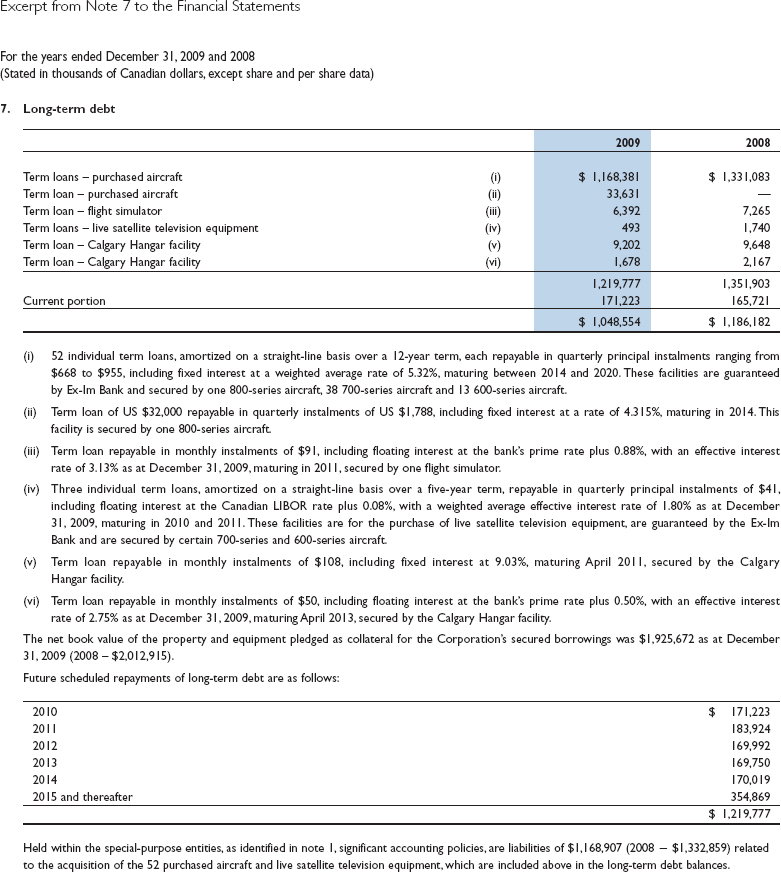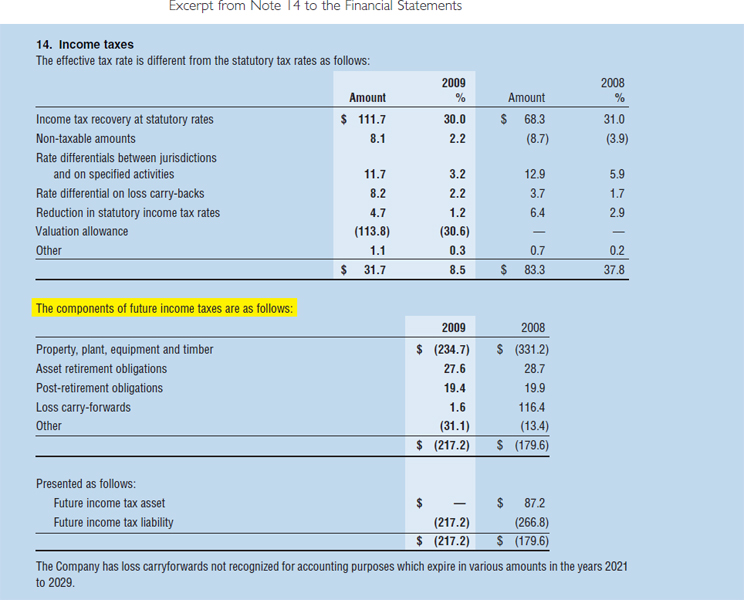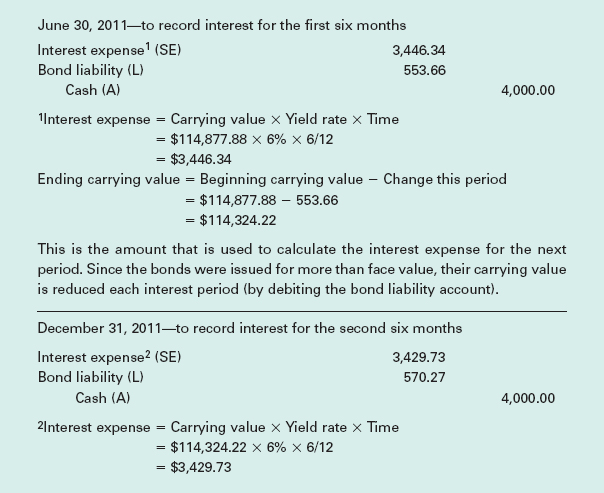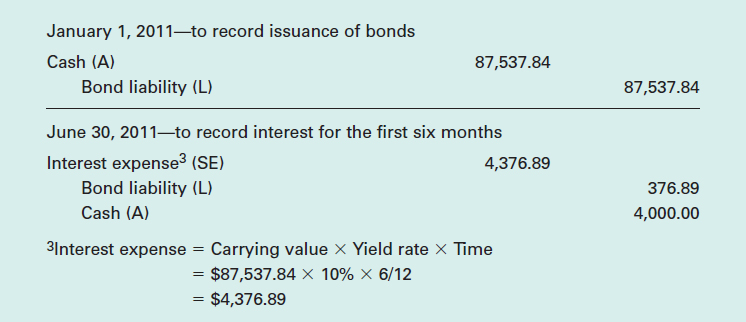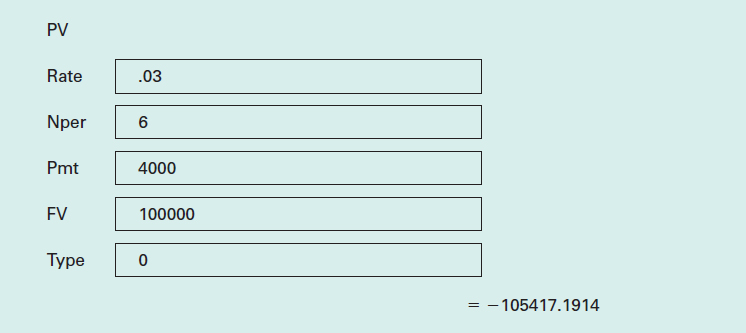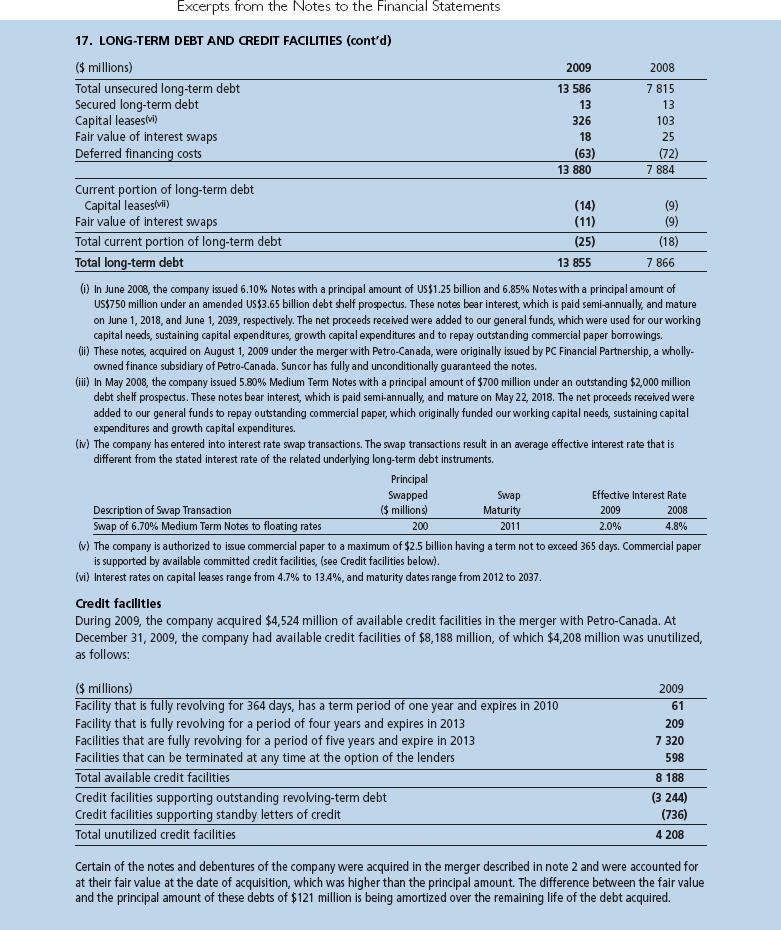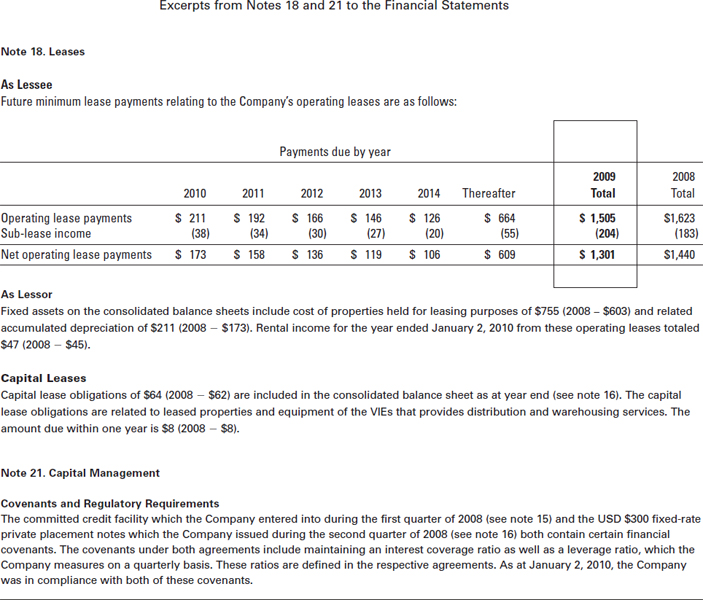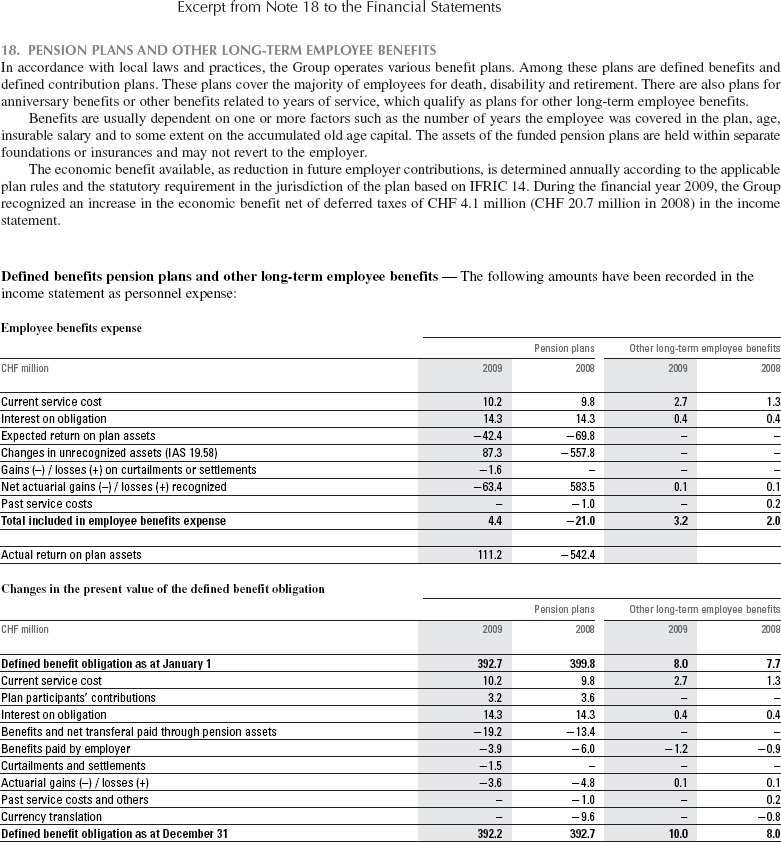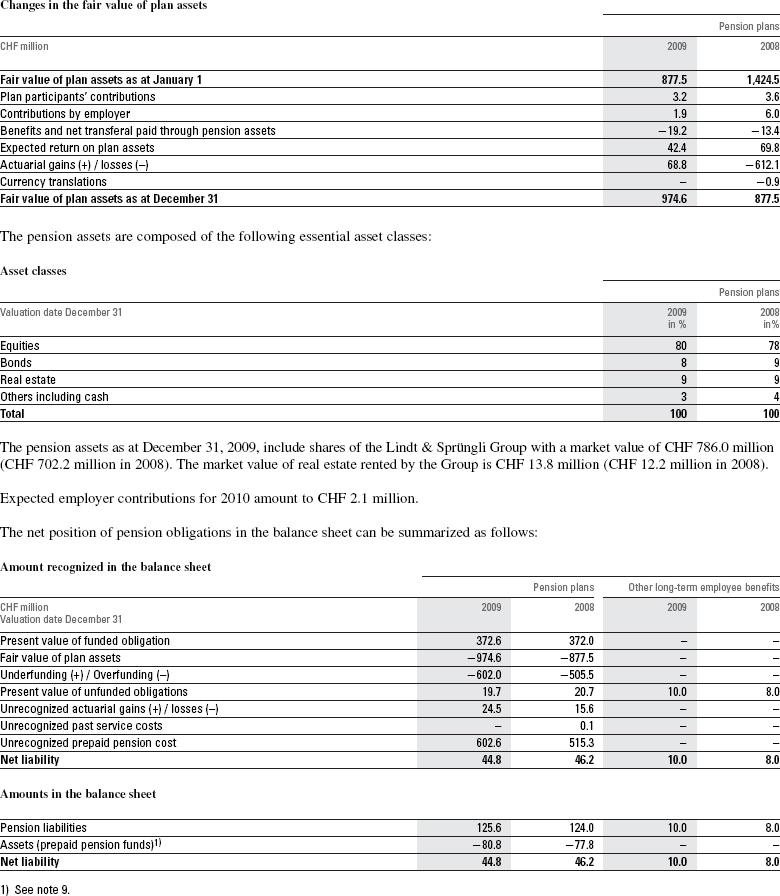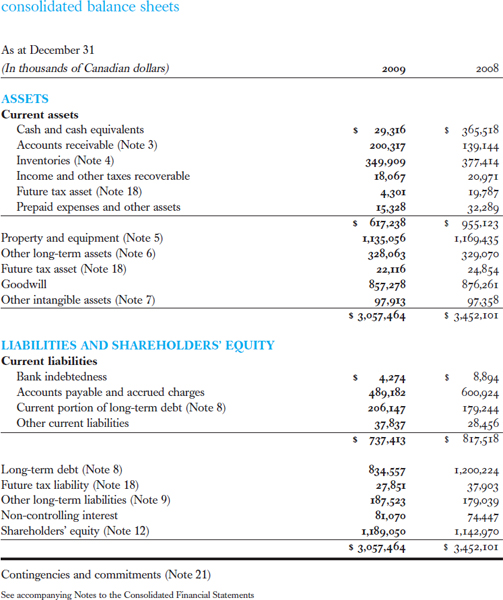chapter 10
LONG-TERM DEBT AND OTHER NON-CURRENT LIABILITIES
Long-Term Loans with Equal Blended Monthly Payments
Long-Term Loans with Monthly Payments of Interest Only
Bond Pricing in the Marketplace
Calculating Bond Interest Expense and Liability Balances
Repayment of Bonds at Maturity
Long-Term Notes or Bonds with No Explicit Interest
Defined Contribution Pension Plans
OTHER POST-EMPLOYMENT BENEFITS
LEARNING OBJECTIVES
After studying this chapter, you should be able to:
- Calculate interest and record transactions related to long-term notes and mortgages.
- Describe the basic characteristics of bonds.
- Explain how bonds are issued and how the pricing of bonds is affected by market factors.
- Calculate a bond's selling price and prepare journal entries to record the issuance and subsequent interest payments for bonds sold at par, below par, and above par.
- Discuss the advantages and disadvantages of leasing.
- Distinguish between operating leases and capital/finance leases, and prepare journal entries for a lessee under both types of leases.
- Explain the distinguishing features of defined-contribution pension plans and defined-benefit pension plans.
- Outline the accounting issues in the reporting of pension plan liabilities.
- Describe other post-employment benefits and explain how they are treated in Canada.
- Explain why deferred/future income taxes exist, and describe how they are reported.
- Record deferred/future income taxes in simple situations.
- Calculate the debt to total assets ratio and the times interest earned ratio, and comment on a company's financial health using the information from these ratios.
Canada Post Borrows for the Future
In early 2010, Canada Post Corporation announced plans to raise at least $1 billion in the Canadian capital markets, starting in late 2010 or early 2011. Although it has about $55 million in long-term debt, this would be the first time that the Crown corporation has taken on a significant long-term liability.
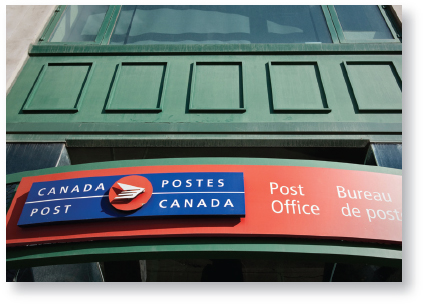
There are basically three forms of financing, explains Wayne Cheeseman, Canada Post's chief financial officer. “There's internally generated funds, the equity market, or the debt capital markets. Being a Crown corporation, the equity markets aren't open to us. We do generate funds internally, but they won't be sufficient when we look at our long-term plans. So we're looking to the debt capital markets and raising money there, obviously with a plan to pay that off over time.”
Canada Post will likely issue the debt in several tranches of $500 million per tranche over five years, says Mr. Cheeseman. At the time of writing, the corporation was in the process of selecting its financial advisors. Details like the number of units, the unit price, and coupon rate would be determined later. “Right now, we're looking at when would be an optimum time for us to go to the markets,” says Mr. Cheeseman.
The decision to raise money through debt followed Parliament's assent to a legal amendment that would increase Canada Post's borrowing limit from $300 million to $2.5 billion. “We do have to go back to the Department of Finance to get approval on the terms and conditions, but the legislative approval is in place,” says Mr. Cheeseman.
The money raised will be used primarily for Canada Post's Postal Transformation Initiative currently underway. “The Postal Transformation Initiative involves redoing and upgrading our physical and technological platform,” says Mr. Cheeseman. The corporation is working to modernize its operations with several capital projects planned over several years, including new and renovated buildings and updated equipment and systems. The initiative includes building a new processing plant in Winnipeg; replacing part of its current fleet with fuel-efficient, low-emission vehicles; and implementing new sorting equipment in its plants. Once the initiative is completed, the company will have a much greater ability to track and trace parcels, and more accurate address management systems.
“We basically have two goals—to provide an acceptable level of service to all Canadians while remaining financially self-sufficient,” says Mr. Cheeseman. These improvements are expected to save Canada Post approximately $250 million a year. “With the cost savings, we're going to take advantage of the coming attrition in the business. It won't be a situation where people lose their jobs. It's simply as they retire, we won't replace a number of people.”
With these long-term plans, Canada Post hopes to remain viable and relevant in Canada's rapidly changing and technologically advancing society.
Businesses often use long-term debt or the issuance of new shares as a means of raising outside capital that they can then use to finance growth. By using the new cash to buy long-term assets or invest in other companies, they can improve or expand their existing operations or enter new markets. In the opening story, Canada Post decided to use long-term debt to acquire the funds it needs in order to buy capital assets that will improve its operating efficiency.1 The story mentions that Canada Post is staggering the debt by issuing it in tranches. French for “slices,” the term “tranches” refers to portions of the total amount. This allows the corporation to borrow the funds only as it needs them, thus minimizing its interest charges.
Long-term debt is usually preferable to short-term debt for financing the acquisition of long-term assets, because both the benefits from the expansion efforts and the payments on the debt will be spread over a long period of time. The cash generated from the growth can then be used to repay the debt.
As you will see later in this chapter, companies are usually able to borrow at an interest rate that is lower than the rate of return they will earn from the income-generating activities that the borrowed money will be used for. This phenomenon is called financial leverage, and can be used to increase the rate of return earned by the shareholders.
Sometimes new debt is simply used to pay off old debt, which is referred to as re-financing or rollover of debt. When short-term debt is repaid with the proceeds from long-term debt, a company is able to spread out its debt payments over a longer time period, which means that there is less pressure on short-term cash needs.
USER RELEVANCE
Users of financial statement information need to pay particular attention to the type and extent of debt in a company. All debt must be repaid at some time. In addition to the principal amount, there is usually a requirement to make periodic interest payments. In terms of a company's “cost of capital” (a topic that is studied in finance courses), issuing debt is cheaper than issuing shares. It also does not dilute the current shareholders' ownership interests, as would an issuance of more shares. However, a company cannot rely too extensively on debt for financing: debt involves risks, and stakeholders become concerned if the proportion of debt to equity financing gets too high. When the level of debt is high, lenders demand higher interest rates to compensate for the increased risks.
As a user of financial statements, you should find answers to the following questions when evaluating a company's debt:
- What are the maturity dates and interest rates on the debt? Knowing this will enable you to determine the amount and timing of the future cash flows that will be necessary to meet the debt obligations.
- Are there any special conditions attached to the debt? For example, is the company required to maintain a certain debt/equity ratio or level of retained earnings? Failure to meet debt conditions (called covenants) could make the debt become due immediately, which could have very serious consequences for the business.
- What is the proportion of debt to equity financing? The higher the amount of debt to equity, the greater the risk that the company may have difficulty meeting the debt requirements. Not only could a high proportion of debt to equity result in higher interest rates being charged to the company, it could also make lenders reluctant to extend further credit to the company, which may affect its future financial viability.
- Is the organization using leverage to the advantage of its shareholders? In other words, is it earning a rate of return on its investment that is higher than the cost of the debt? As a user, you will want to examine the company's financial statements to see if leverage is being used effectively.
In this chapter, we are going to illustrate some of the most common non-current liabilities, including long-term loans, bonds payable, lease liabilities, pension and other post-employment benefit liabilities, and deferred income taxes. The general nature of liabilities was discussed in Chapter 9, along with the recognition and valuation criteria for liabilities. You might want to refresh your memory before moving on.
LONG-TERM NOTES AND MORTGAGES
When a company chooses to use long-term debt financing, it can go to various sources to obtain the funds, including the commercial paper market. “Commercial paper” is a promissory note that is sold to another business. In effect, one company (the issuer of the note) borrows funds directly from another (the buyer of the note). However, the commercial paper market is generally used only by large companies that have high credit ratings. More commonly, companies borrow from commercial banks or other financial institutions, much as individuals borrow money to buy a new home or car. These borrowings are often listed on a company's financial statements as long-term notes payable, loans payable, or mortgages.
All types of long-term debt are usually accompanied by a formal agreement between the borrower and the lender that specifies the terms of the loan (such as the interest rate, payment dates, and duration of the loan). In addition, the loan agreement often specifies certain conditions that the borrower must meet during the loan period. These conditions or restrictions on the company are known as covenants. The covenants may limit the company's freedom to borrow additional amounts, to sell or acquire assets, or to pay dividends. The restrictions specified in the covenants are intended to protect the lender against the borrower defaulting on the loan.
The accounting for long-term notes payable is much the same as for short-term notes, which was discussed and illustrated in Chapter 9. Long-term borrowings almost always have explicit interest charges, and in most cases these are paid periodically during the life of the loan. However, even if the interest is not explicitly stated or is paid only at maturity, interest expense should be recognized over the life of the loan.
LEARNING OBJECTIVE 1
Calculate interest and record transactions related to long-term notes and mortgages.
Long-Term Loans with Equal Blended Monthly Payments
A mortgage loan is simply a long-term debt with a capital asset—such as a building or piece of equipment—pledged as collateral or security for the loan. If the borrower fails to repay the loan according to the specified terms, the lender has the legal right to have the asset seized and sold, and the proceeds from the sale applied to the repayment of the debt.
Mortgages are usually instalment loans. As discussed in Chapter 9, this means that payments are made periodically rather than only at the end of the loan. Also, the periodic payments are usually blended payments, consisting of both interest and principal components. The total amount of the payment is the same each period, but the portion of each payment that is consumed by interest is reduced as the principal balance is reduced.
To illustrate this, we will consider the case of a company that takes out a three-year, $100,000 mortgage on September 30. The interest rate on the loan is 6% per year, and equal blended payments of $3,042.19 are to be made at the end of each month. (This amount can be calculated using the interest tables provided on the inside covers of the book. Simply divide the $100,000 principal, or present value, by the present value factor for an annuity of 36 periods [3 years × 12 months per year = 36 months] at an interest rate of 0.5% per period [6% per year ÷ 12 months per year = 0.5% per month]: $100,000 ÷ 32.87102 = $3,042.19. Alternatively, the monthly payments required to repay the loan can be calculated using the payment function in a financial calculator or computer spreadsheet, such as Excel. Simply enter 0.005 for the interest rate per period, 36 for the number of periods, and 100,000 for the principal or present value. This will return a result of 3,042.19 for the payment.)
Exhibit 10-1 presents a loan amortization table for this mortgage, showing how the first portion of each of the payments is allocated to the monthly interest charge, with the remaining portion being applied to reduce the principal balance of the loan.
Notice that $500 of the first payment is consumed by interest and only $2,542 is left to be applied to the reduction of the principal. By contrast, only $15 of the last payment is consumed by interest, leaving $3,027 to be applied to the reduction of the principal.
The journal entries to record the initial borrowing and the first three payments on the mortgage are as follows:
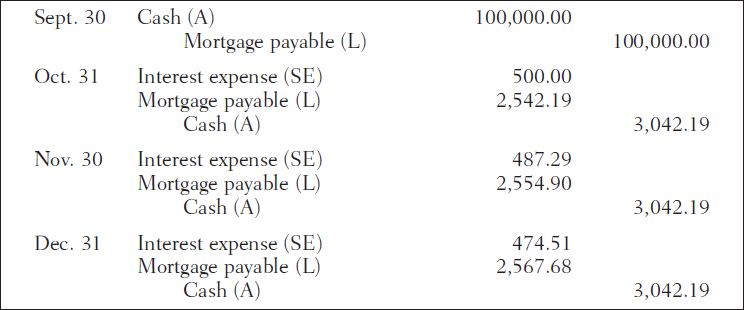
Long-Term Loans with Monthly Payments of Interest Only
To illustrate a different type of loan arrangement, we will now consider the case of a company that takes out a three-year loan for $100,000 at 6% on September 30, with terms that specify that only the interest on the loan is to be paid each month; the principal is to be repaid as a lump sum when the note matures at the end of the three-year period.
EXHIBIT 10-1 LOAN AMORTIZATION TABLE
For a three-year, 6% mortgage of $100,000 with payments made at the end of each month
Note the key difference between this situation and the previous one: in this case, there are no reductions in the principal of the loan during its life. In this type of situation a loan amortization table is not necessary, since the principal balance remains the same from the inception of the loan until it is repaid in full at maturity. Consequently, the amount of interest remains the same each month: $100,000 × 6% × 1/12 = $500.
The journal entries to record the initial borrowing and the first three interest payments on the note are as follows:

We chose to use the account title “Long-term note payable” for this liability. However, alternatives such as “Long-term bank loan” are also commonly used.
EARNINGS MANAGEMENT
Debt covenants usually include financial measures or tests, such as ratios, that the borrowers must satisfy; otherwise, the debt will become due and payable on demand. As a result, restrictive covenants can create environments that encourage bias in accounting and financial reporting. That is, debt covenants may put so much pressure on companies to achieve the required minimums and pass the tests that managers engage in aggressive accounting and business practices to satisfy the covenants.
Users of financial statements should therefore be aware of the existence and nature of key debt covenants, and alert to the potential for manipulation of the financial statements to satisfy them.
Exhibit 10-2 is an excerpt from the notes to the 2009 financial statements of West Jet Airlines Inc., describing the various components of long-term debt outstanding. Notice that the term loans consist of blended payments of interest and principal, payable monthly or quarterly, and each loan is secured by a specific piece or type of equipment. For 2009, the total amount of property and equipment pledged as security is $1,925,672 thousand. The interest rates vary by loan, depending on when the loans were taken out, and some loans have fixed interest rates while others have floating rates. The last part of the note indicates the loan repayments required over the next five years and the total amount due after that.
BONDS AND DEBENTURES
When a large company wants to borrow long-term funds to support its operations, it does not always have to take a loan from a specific lender such as a bank or other financial institution. Instead, it can get the funds from “the market” by issuing bonds.
EXHIBIT 10-2 WEST JET AIRLINES INC. 2009 ANNUAL REPORT
WEST JET AIRLINES INC. 2009 ANNUAL REPORT
LEARNING OBJECTIVE 2
Describe the basic characteristics of bonds.
Basic Bond Characteristics
A bond is a formal agreement between a borrower (the company that issues the bonds) and the lenders (the investors who buy the bonds) that specifies how the borrower is to pay back the lenders, as well as any conditions that the borrower must meet while the bonds are outstanding. The bond's terms, conditions, restrictions, and covenants are usually stated in a document called an indenture agreement.
Bonds that are traded in public markets are fairly standardized. The indenture agreement will state a face value or principal amount for the bonds, which is usually $1,000 per bond. The face value specifies the cash payment that the borrower will make to the lenders at the bond's maturity date. In addition to the cash payment at maturity, most bonds also include semi-annual interest payments to the lenders. The amount of these payments is determined by multiplying the bond interest rate by the face value and dividing by two (because the interest payments are semi-annual). The bond interest rate is stated as an annual percentage and is usually not the effective or true interest rate, but simply a rate that determines the periodic amount of the interest payments.
Another important item in the indenture agreement is the collateral (if any) that the company pledges as security to the lenders. If collateral is pledged, it means that, if the company defaults on either the interest payments or the maturity payment, the bondholders can force the pledged assets to be sold in order to settle the debt. A “mortgage bond” has real property (fixed assets) pledged as collateral. A collateral trust bond usually has shares and bonds of other companies pledged as collateral.
A bond that carries no specific collateral but is backed by the company's general creditworthiness is known as a debenture bond, or simply a debenture. Debenture bonds can be either senior or subordinated debentures. The distinction between senior and subordinated is the order in which the investors (creditors) are paid in the event of bankruptcy: senior creditors are paid before subordinate claims.
Some indenture agreements specify special provisions that are designed to make the bonds more attractive to investors. Convertible bonds, for example, can be exchanged for or converted to a specified number of common shares in the company issuing them.
Sometimes bonds are sold directly to investors through what is referred to as a “private placement”. These types of bonds do not trade in public markets. Private placements are usually made to institutional investors, such as the trustees in charge of large pension funds.
Generally, bonds are sold initially to institutional and individual investors through an investment banker. The investment banker sells the bonds to its clients before the bonds are traded in the open market, and gets a commission for handling the transaction. The investment banker first consults with the company about its objectives, and helps design an issue that will both meet the company's objectives and attract investors. All the bond features that have been discussed in the previous sections will be considered when structuring the offering.
The investment banker is responsible for the initial sale of the issue to its clients. Because most issues involve larger amounts than one investment banker can easily sell, the investment banker usually forms a syndicate with other investment bankers, who will be jointly responsible for selling the issue. The syndicate members are sometimes known as the underwriters of the issue.
Once the bonds have been sold by the investment bankers, they can be freely traded between investors in the bond market—much as shares are traded on the stock market. At this point, any investors can buy or sell the bonds. The prices of the bonds will then fluctuate according to the forces of supply and demand, and with changes in economic conditions.
accounting in the news
Bonds Yield Sweet Returns
UK chocolatier Hotel Chocolat is raising funds in a unique way, by issuing bonds that will pay out in chocolate rather than money. Members of Hotel Chocolat's Tasting Club have been offered two investment options: a three-year £2,000 ($3,030 CAD) bond, for which they will receive a box of chocolates valued at £18 ($27 CAD) every two weeks (equivalent to a 6.7% yield); or a three-year £4,000 ($6,058 CAD) bond that will pay out the equivalent of a 7.3% yield in chocolate. Although the company will be paying yields that are higher than standard bond rates, the cost of making the boxes of chocolates is much less than their market value. With 100,000 Tasting Club members, who already pay for discounts, special offers, and regular home deliveries of chocolate samples, Hotel Chocolat hopes to raise £5 million ($7.5 million CAD) through the bond issue. The transaction is an alternative to bank loan financing, since its size is too small for a typical bond issue. The company has appointed BDO as its advisor and has received approval from the UK Financial Services Authority. It plans to use the funds raised to expand its chain of retail outlets, develop a new plantation in St. Lucia, and expand its business overseas.

Sources: Natalie Harrison, “Candy Bond Investors Get Paid in Chocolate,” Reuters, May 24, 2010; Jason Hesse, “Hotel Chocolat Offers a Sweet Deal to Chocoholics,” Real Business—The Champion of UK Enterprise, http://realbusiness.co.uk/sales_and_marketing/hotel_chocolat_offers_a_sweet_deal_to_chocoholics
LEARNING OBJECTIVE 3
Explain how bonds are issued and how the pricing of bonds is affected by market factors.
Bond Pricing in the Marketplace
Bond prices are established in the marketplace by the economic forces of supply (from companies wanting to sell bonds) and demand (from investors wanting to buy them). The buyers determine what the cash flows are going to be for the bonds—both in the periodic interest payments and the eventual repayment of the principal amount—and the rate of return they want to earn, based on the risk of potential default by the company. They then use these amounts to calculate the present value of the cash flows they will receive from the bonds, to determine the amount they are willing to pay for them.
The process of calculating the present value of bonds involves discounting (at the desired earnings rate) the future cash flows from the bonds (periodic interest payments and repayment of principal). Potential buyers determine the yield (or desired rate of return) by looking at the interest rates that could be earned from alternative investments and the relative risk of the particular bond issue. The higher the level of risk, the higher the yield rate has to be. In other words, for buyers to accept a higher risk of default, they have to be compensated for that risk with a higher rate of return. Buyers also have to factor in any special features of the bonds, such as if they are convertible into shares. However, to keep things as simple as possible in the rest of this section, these special features will be ignored as we discuss bond pricing.
The starting point in determining a bond's value is to calculate the cash flows that will be received by the buyer (and paid by the seller). To illustrate the calculation of interest payments and bond values, we will use the following example.
LEARNING OBJECTIVE 4
Calculate a bond's selling price and prepare journal entries to record the issuance and subsequent interest payments for bonds sold at par, below par, and above par.
Baum Company issues bonds on December 31, 2011, with a total face value of $100,000, a bond interest rate of 8%, and a maturity date of December 31, 2014. The company must make a $100,000 payment to the lenders on December 31, 2014, and must make interest payments every six months of $4,000 each. The $4,000 amount is calculated as follows:

The bond interest rate is sometimes referred to as the coupon rate, stated rate, or nominal rate. All of these terms refer to the rate of interest that is specified in the bond contract and is used to calculate the interest payments.
There will be a total of six interest payments, because there are three years to maturity and two interest payments per year. The interest payments on a bond are typically structured to come at the end of each six-month period. The stream of interest payments is called an annuity in arrears, meaning that it is a series of equal payments that are made at the end of each period.
Although these bonds have a face value of $100,000, they may sell for more or less than this amount. Bond selling prices are determined by competitive forces in the bond market, because there are always many other bonds that investors could purchase. If a particular bond issue looks attractive, in comparison to bonds of similar duration and risk, investors will be willing to pay a premium price (i.e., more than the face value) to purchase them. On the other hand, if the terms are unattractive in comparison to bonds of similar duration and risk, investors will only be willing to purchase the bonds if they can do so at a discounted price (i.e., less than their face value).
Case 1: The bond interest rate is lower than the required yield
To illustrate this, suppose that when Baum issues its bonds the competitive interest rate in the market for bonds of similar duration and risk is 10%, compounded semi-annually. This competitive market rate of interest is often called the yield or effective interest rate. Since investors could buy other, similar bonds and earn a rate of return of 10%, they will not buy Baum's bonds unless they can earn the same rate of return or yield.
HELPFUL HINT
There are many terms for interest rates in the context of bonds:
- The interest rate to determine the interest payments is referred to as the bond rate, the coupon rate, the stated rate, the nominal rate, or the contract rate.
- The interest rate to determine the selling price of the bonds and the interest expense is referred to as the market rate, the effective rate, or the yield.
To determine exactly how much they are willing to pay for Baum's bonds, investors look at the cash flows that Baum will pay them, and then discount these cash flows using the yield rate of 10%. Exhibit 10-3 shows the timeline and the cash flows for this bond.
Note that the interest payments (the six payments of $4,000 each) are an annuity in arrears and that the maturity payment ($100,000) is a lump-sum cash flow at the end of the sixth period. There are six periods because interest payments are made twice each year. The bonds' issuance price will be determined by calculating the present value of these cash flows, based on the 5% semi-annual yield or effective rate of interest.
To calculate the present value of the bonds' future cash flows, we will use the Time Value of Money tables located on the inside covers. Alternatively, the appendix on pages 680–682 shows how the PV (present value) function in Microsoft® Excel can be used to calculate these amounts. These calculations can also be done using a financial calculator that has present value functions. To find out how to calculate these amounts on a financial calculator, go to the Study Tools section on the student website at http://www.wiley.com/hoskin.
EXHIBIT 10-3 BAUM COMPANY BONDS
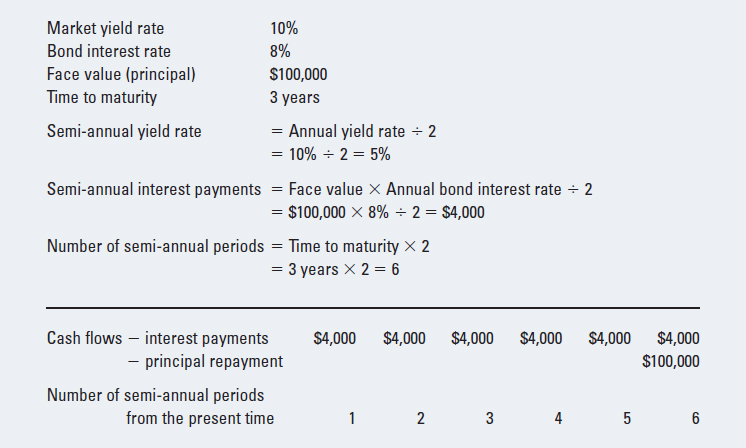

Study Tools
The two Time Value of Money tables printed on the inside covers contain pre-calculated factors for various combinations of interest rates and time periods. The present value of the cash flows is determined by multiplying the cash flow amounts by the appropriate factors from the tables. The factors in these tables are sometimes referred to as discount factors, and the results are referred to as discounted cash flows.
Notice that the heading on Table 1 is “Present Value Factors for an Annuity in Arrears.” Since an annuity is a series of equal payments, Table 1 will be used for the interest payments. By contrast, the heading on Table 2 is “Present Value Factors for a Lump-Sum Payment.” Since the principal is repaid only once, as a lump sum when the bonds mature, Table 2 will be used for the principal payment.
To calculate the present value of Baum's bonds, we first need to multiply the amount of the interest payments by the factor from Table 1 for an annuity of 6 periods (since there are 6 interest payments) discounted at an interest rate of 5% (the market rate of interest for each six-month period). Looking in Table 1, where the row for 6 periods intersects with the column for 5%, you will see that the appropriate present value factor is 5.07569. Multiplying the amount of the interest payments ($4,000) by this factor gives $20,302.76. This is the present value of a series of 6 semiannual future payments of $4,000 each, when the competitive rate of return is 5% per period. This is the amount that investors will be willing to pay now, to receive these interest payments in the future.
Next, we need to multiply the amount of the principal payment by the factor from Table 2 for a lump-sum payment to be made after 6 periods, discounted at the same interest rate of 5% (the yield or market rate). Looking in Table 2, where the row for 6 periods intersects with the column for 5%, you should find the present value factor 0.74622. Multiplying the amount of the principal payment ($100,000) by this factor gives $74,622.00. This is the present value of a future payment of $100,000 after 6 semi-annual periods, when the competitive rate of return is 5% per period. This is the amount that investors will be willing to pay now, to receive this principal payment in the future.
The total present value of the bonds is the sum of these two amounts: $20,302.76 (for the interest) + $74,622.00 (for the principal) = $94,924.76. This is the amount that investors will pay for Baum's bonds. Notice that it is less than the $100,000 face value of the bonds. This is because these bonds pay interest of only 8% (4% semiannually), while the market rate of interest is 10% (5% semi-annually). Since Baum's bonds pay less interest than comparable bonds from other companies, investors will not be willing to pay full price for them.
Case 2: The bond interest rate is higher than the required yield
How does a different required rate of return or yield affect the value of the bonds? Suppose that instead of 10% the competitive rate of interest in the market for this type of bond is 6%. The only thing that will change in the calculation is the present value factors that are used, as the following shows:
Present value of the Baum Company bonds if the market rate of interest is 6% (3% per semi-annual period):

Notice that this is more than the $100,000 face value of the bonds. This is because these bonds pay interest of 8% (4% semi-annually), while the market rate of interest is only 6% (3% semi-annually). Since, under this scenario, Baum's bonds pay more interest than comparable bonds from other companies, investors will be willing to pay extra for them.
In bond pricing terminology, when bonds are sold for more than their face value they are said to be sold at a premium. When bonds are sold for less than their face value, they are said to be sold at a discount. If they are sold for exactly their face value, they are said to be sold at par. You should avoid placing any connotations on the words “premium” and “discount.” They do not mean either that the buyers paid too much or that they got a good deal. In competitive financial markets, the amount that investors pay—whether it is premium, discount, or par value—is always the appropriate price for the bond, given the yield or market rate for similar bonds.
Case 3: The bond interest rate is the same as the required yield
What yield rate would have to be used in the example for the bonds to be issued at par? The answer is 8%, because in this case the required yield or market interest rate is the same as the bond interest rate. Whenever the interest rate paid by bonds is exactly equal to the required yield or market rate, the bonds will sell at par. When the bond interest rate is lower than the market rate, the bonds will not be very attractive compared to alternative investments and will therefore sell at a discount. On the other hand, when the bond interest rate is higher than the market rate, the bonds will be relatively attractive and will therefore sell at a premium. This should seem logical to you, if you think of it from a buyer's point of view.
You may be wondering why a company would issue (sell) its bonds at other than their par value. Companies generally try to set the interest rate on their bonds to be close to the interest rate that the market will demand (i.e., at what they expect the competitive rate of interest to be). However, when a company decides to issue bonds as a way of raising capital, it is usually a long process. It must first get financial advice and legal advice on aspects of the indenture agreement, and then get the necessary approvals and have the bond certificates printed and ready for issue. By the time the bonds are actually issued to investors, the market's assessment of the company's risk may have changed, and/or general economic conditions may have changed. In such cases, the bond interest rate will differ from the market rate and, as a result, the bonds will sell at a discount or a premium rather than at their par value.
A final point to note about bond pricing terminology is that bond prices are typically expressed out of 100. For example, a $1,000 bond selling for $949 is said to be selling at 94.9, meaning 94.9% of its face value. Similarly, a $1,000 bond selling for $1,054 is said to be selling at 105.4, representing 105.4% of its face value, and a bond selling for its par value is said to be selling at 100.
Calculating Bond Interest Expense and Liability Balances
Exhibit 10-4 presents amortization tables for the Baum Company bonds, under the three scenarios discussed above. These have been prepared in the same way as the amortization tables for various loans, notes, and mortgages presented in Chapter 9 and earlier in this chapter.
In each case, the interest payment is calculated using the face value and the bond interest rate, while the interest expense is calculated using the liability balance and the yield or market rate.
Notice that when the bonds are issued at a discount, the liability balance starts at less than the face value and increases over the life of the bonds, until it equals the face value when the bonds are due for repayment. Conversely, when the bonds are issued at a premium, the bond liability starts at more than the face value and decreases as each interest payment is made, until it equals the face value when the bonds mature. When the bonds are issued at their par value, the liability balance is the same as the face value over the entire life of the bonds. In each case, the final bond liability equals the principal amount to be repaid when the bonds are due for repayment.
EXHIBIT 10-4 BOND AMORTIZATION TABLES FOR THE BAUM COMPANY EXAMPLE
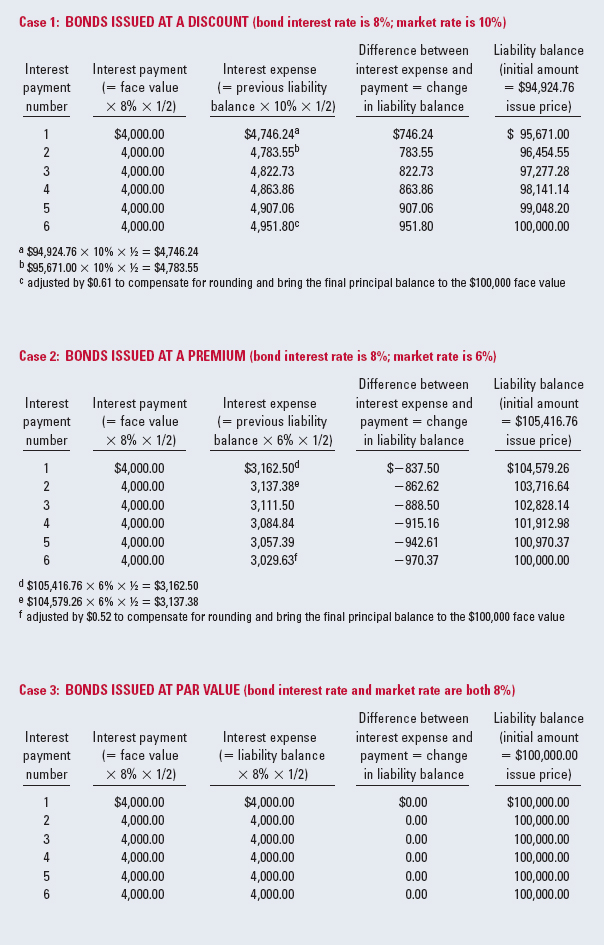
Accounting for Bonds
Continuing with the Baum Company example, we now illustrate the journal entries for bond accounting. The entries to record the issuance of the bonds and the first two interest payments are shown below, for each of the three scenarios developed earlier (issued at a discount, at a premium, and at par). For the interest entries, the amounts are taken from the amortization tables in Exhibit 10-4.
Case 1: Bonds issued at a discount
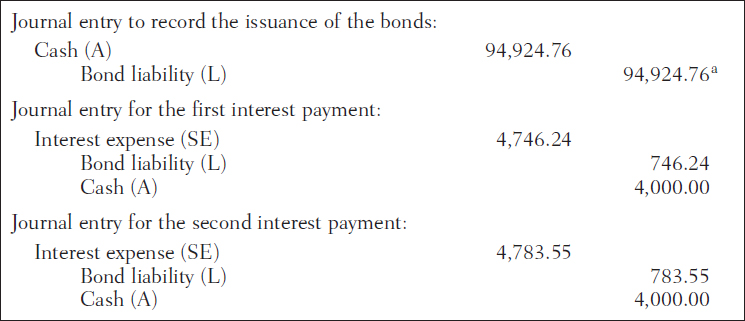
HELPFUL HINT
When calculating bond interest, remember the following:
- The interest payment is calculated using the values specified in the bond contract: the bond interest rate and the face value of the bonds. Since these are both constants, the interest payment is a constant amount—the same for each semiannual interest period throughout the life of the bonds.
- The interest expense is calculated using the yield or market rate of interest at the time the bonds were issued (the same rate used in the present value calculations that determine the selling price) and the previous liability balance. For bonds issued at a discount or a premium, the liability balance changes each period and the interest expense is therefore a different amount each period.
Notice that when bonds are issued at a discount there is a difference between the amount of interest expense and the amount of interest paid in cash, and this difference increases the liability balance over the life of the bonds. This is done each interest period, and results in the bond liability at the maturity date equalling the face value of the bonds. Increasing the bond liability is necessary because, when the bonds mature, the company has to repay the full face value of the bonds ($100,000), not just the amount ($94,924.76) that was received when the bonds were issued.
Case 2: Bonds issued at a premium

a Traditionally, accountants would have recorded this in two parts: a $100,000.00 credit to Bonds Payable, partially offset by a $5,075.24 debit to a contra-liability account called Discount on Bonds Payable. For the statement of financial position, the contra-liability for the discount on the bonds would be deducted from the bonds payable account, to show the net liability of $94,924.76. As each interest payment was recorded, a portion of the discount would be amortized as interest expense.
Since using a Discount on Bonds Payable account makes the accounting procedures significantly more complex, does not affect the final outcome, and is not encouraged under International Financial Reporting Standards, we use the much simpler approach illustrated above.
bTraditionally, accountants would have recorded this in two parts: a $100,000.00 credit to Bonds Payable and a $5,416.76 credit to an adjunct liability account called Premium on Bonds Payable. For the statement of financial position, the adjunct liability for the premium on the bonds would be added to the bonds payable account, to show the total liability of $105,416.76. As each interest payment was recorded, a portion of the premium would be amortized against interest expense.
Since using a Premium on Bonds Payable account makes the accounting procedures significantly more complex, does not affect the final outcome, and is not encouraged under International Financial Reporting Standards, we use the simpler approach illustrated above.
Notice that when the bonds are issued at a premium the difference between the amount of interest expense and the amount of interest paid in cash decreases the liability balance over the life of the bonds. This will result in the bond liability at the maturity date equalling the face value of the bonds. This is logical, because the company will have to repay only the $100,000 face value of the bonds at maturity, not the $105,416.76 that was received when they were issued.
Case 3: Bonds issued at par value
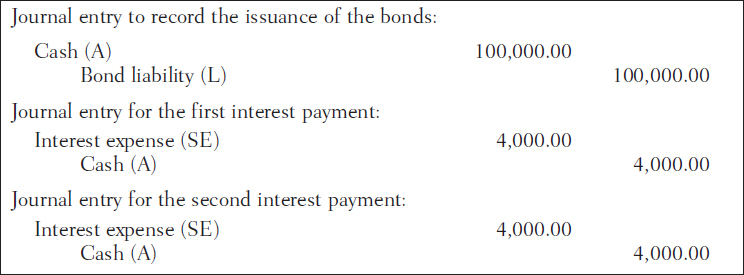
Repayment of Bonds at Maturity
As shown in Exhibit 10-4, whether bonds are issued at a discount, at a premium, or at par, when they reach their maturity date the liability balance equals the face value. Consequently, the journal entry to record the retirement or repayment of the bonds is the same in all three cases. For the Baum Company bonds, the entry is as follows:
![]()
Early Retirement of Debt
Although a company does not have to pay off its debts until they mature, there are times when it makes sense to pay a debt earlier. This transaction is known as early retirement, or early extinguishment, of debt.
Some bonds may have a “call feature” that allows the issuing company to buy them back at a predetermined price before they mature. These are referred to as callable bonds. Otherwise, bonds can be retired before maturity by simply buying them in the bond market. Whether they are called or purchased in the open market, it is likely that the bond liability or carrying value of the bonds will be different from the amount paid to retire them. Consequently, a gain or loss will usually arise when debt is retired early.
To demonstrate the accounting for an early retirement of debt, suppose the Baum Company bonds were called or bought back after two years for a price of $101,000.
For case 1, where the bonds were issued at a discount, Exhibit 10-4 shows that the bond liability after two years (i.e., after four interest payments) is $98,141.14. Since the company pays $101,000 to retire a debt that is on the books at only $98,141.14, it records a loss for the difference. The journal entry to record the early retirement of the bonds in this case is as follows:

For case 2, where the bonds were issued at a premium, Exhibit 10-4 shows that the bond liability after two years is $101,912.98. Since the company pays only $101,000 to retire a debt that is on the books at $101,912.98, it records a gain equal to the difference. The journal entry to record the early retirement of the bonds in this case is as follows:

This case illustrates one reason why a company may decide to retire its debt early: if the cost to retire the debt is lower than the amount of the bond liability on the books, a gain will be recorded. The downside of this, however, is that if the company needs to raise more capital through the use of debt, it may have to pay a higher interest rate for the new debt. If so, the one-time gain on the retirement of the debt in the current period could be offset by ongoing higher interest costs in future periods. Under these circumstances, the company may not really be better off (as suggested by the gain) for having retired its old debt.
For case 3, where the bonds were issued at par value, Exhibit 10-4 shows that the bond liability after two years (or at any point during the life of the bonds) is $100,000. Since $101,000 is paid to retire a debt that is on the books at only $100,000, a loss is recognized for the difference. The journal entry to record the early retirement of the bonds in this case is as follows:

EARNINGS MANAGEMENT
The early retirement of debt is a discretionary action by management, and one which can often result in significant gains or losses being reported on the statement of earnings. Users of financial statements should therefore be aware that managers may be tempted to manipulate the financial statements through early debt retirements, and should critically evaluate management's reasoning and the economic justification for any early retirement of debt.
Long-Term Notes or Bonds with No Explicit Interest
Sometimes bonds or long-term notes are issued with no provision for interest on them. This is most commonly done in financing arrangements for the purchase of long-term assets. For example, suppose a company negotiates the purchase of some equipment for $100,000, which is to be paid at the end of three years with no interest added. In this situation, accounting principles would say that the appropriate value for recording this equipment and the related note payable is whatever it would have cost the company to purchase the equipment in cash paid immediately. The true value of the asset is not the $100,000 that will be paid in three years, because surely the equipment could have been acquired for less if the company had purchased it for cash. Similarly, the initial amount of the liability should not be recorded as $100,000, because logically—given the time value of money—the company could settle the debt now for less than the $100,000 that it has agreed to pay after three years.
We can determine the appropriate value for recording the equipment and the related note payable by calculating the present value of the $100,000 that is to be paid at the end of three years, using an appropriate interest rate. For example, if the company would normally have been charged an interest rate of 6% annually for a three-year loan, the discounting factor that should be used is 0.83962 (the PV factor for 3 periods at 6%, from Table 2). The present value of this transaction is $100,000 × 0.83962 = $83,962, and the journal entries to record it are as follows.
To record the acquisition of the asset and the issuance of the note:

To accrue interest for the first year:

To accrue interest for the second year:

To accrue interest for the third year:

To record the payment of the note:
![]()
Note that interest expense is recognized—even though none is explicitly charged—and over the life of the note the liability balance is increased to the amount that is due on its maturity date (i.e., $83,962 + $5,038 + $5,340 + $5,660 = $100,000).
LEARNING OBJECTIVE 5
Discuss the advantages and disadvantages of leasing.
LEASES
When a company needs to use an asset such as a piece of machinery, there are two ways it can obtain the use of the asset. One is to purchase it outright. A second is to enter into a lease agreement in which another company (the lessor) provides the asset and the company that wants to use it (the lessee) makes periodic payments to the lessor in exchange for use of the asset over the length of the lease agreement (the lease term). There are benefits and costs to both alternatives.
One benefit of purchasing the asset and thereby owning it is that the company can depreciate the asset for tax purposes and, in some cases, obtain an investment tax credit for the purchase. Investment tax credits are incentives provided by the Canada Revenue Agency to encourage investment in certain types of assets. These credits usually take the form of a direct reduction in the company's tax bill, based on a percentage of the asset's cost.
A disadvantage of purchasing the asset is that it ties up capital that could have been used for other purposes. Also, if the company has to borrow to buy the asset, the company's debt ratios and interest coverage ratios will change, which could affect its future borrowing capabilities. (These ratios are discussed later in this chapter, and in Chapter 12.)
Realizing a gain from appreciation in the asset's value is another potential benefit of ownership. Of course, the downside is incurring a loss from the asset's decline in value, which could be dramatic if the asset becomes technologically obsolete or loses its market popularity.
On the other hand, leasing often offers several benefits. The main advantage is that it often provides a low-cost form of financing. This is largely due to the fact that the lessor typically has higher taxable income than the lessee and therefore gets larger tax savings from the capital cost allowance deduction, enabling it to offer attractive terms to the lessee.
Another advantage of leasing is that the lessee does not have to put up its own capital to acquire the asset. It also does not have to borrow to buy the asset, which may mean that its debt and interest coverage ratios will not be affected.
A final advantage of leasing is that, because the lessee does not own the asset, the risk of loss from obsolescence usually falls on the lessor. A related advantage is that the lessee may not want to use the asset for its full useful life. If the company wants to use the asset for only a limited period, there is significantly less risk associated with the residual value if the company leases the asset rather than buying it.
LEARNING OBJECTIVE 6
Distinguish between operating leases and capital/finance leases, and prepare journal entries for a lessee under both types of leases.
Classification of Leases
The accounting issues for a lessee are best illustrated using two extreme examples. At one extreme, suppose that the lease contract is signed for a relatively short period of time, say two years, whereas the leased asset's useful life is eight years. In this case, it is clear that the lessee is not buying the asset, but is instead renting it for only a short period. The lease contract is a mutually unexecuted rental contract, and the cash payments required by the lease are recorded by the lessee as simply rent expense and an outflow of cash. This type of lease is known as an operating lease.
Suppose at the other extreme that the lease contract is signed for the asset's entire useful life and that the title to the asset passes to the lessee at the end of the lease term (which is fairly common, in long lease contracts). In this case, the substance of the transaction is that the lessee has, in effect, bought the asset and agreed to pay for it in instalments, in the form of lease payments. There is essentially no difference between this arrangement and one in which the lessee takes out a long-term loan, uses the funds to buy the asset for cash, and then repays the loan in instalments. The lender, in this case, is the lessor. It seems appropriate for the lessee to account for this as a long-term borrowing and a purchase of a long-term asset. The asset is therefore recorded at its cost (measured as the present value of the lease payments), and is depreciated in the same way that a purchased capital asset would be. The account name for the asset often includes reference to the lease aspect (for example, leased equipment or equipment under lease). The obligation to the lessor is recorded as a non-current liability, and interest expense is recognized over the term of the lease. This type of lease has traditionally been known as a capital lease, but under International Financial Reporting Standards is called a finance lease.
Although the appropriate accounting procedures for these extreme situations seem fairly clear, the following question arises: What does the company do when the lease is somewhere in between these extremes? To address this issue, criteria have been developed to distinguish capital/finance leases from operating leases. From the lessee's point of view, the lease qualifies as a capital/finance lease if any of the following criteria are met:
CRITERIA FOR A CAPITAL/FINANCE LEASE
- The lease transfers ownership of the asset to the lessee by the end of the lease term.
Rationale: If the lessee will own the asset at the end of the lease, it is buying the asset; the lease is merely a financing arrangement. - The lessee has an option to purchase the asset at a price that is much lower than its fair value, and it is reasonably certain that this “bargain purchase option” will be exercised.
Rationale: If the lessee is likely to buy the asset at the end of the lease, because it can do so at a bargain price, it is ultimately buying the asset. - The lease term is for the major part of the asset's economic life.
Rationale: If the lessee will have the use of the asset during most of its useful life, it should treat the transaction as if, in substance, it is buying the asset. - The present value of the minimum lease payments is equal to substantially all of the fair value of the asset.
Rationale: If the value being paid to lease the asset is close to the cost of buying it, the lessee should treat the transaction as if, in substance, it is buying the asset. - The leased asset is of such a specialized nature that, without major modifications, only the lessee can use it.
Rationale: If the asset would not be of use to anyone else, then it is reasonable to treat it as an asset that is being sold by the lessor and bought by the lessee.
The underlying spirit of these criteria is that, if the lease arrangement substantially transfers the risks and rewards of ownership of the asset to the lessee, it should be classified as a capital/finance lease and treated as an acquisition of a capital asset and a long-term liability.
In terms of the financial statement effects, companies generally have a strong preference for treating leases as operating leases. This keeps the lease obligations off the statement of financial position (creating a situation often referred to as “off-balance-sheet” financing), and there is therefore no effect on the debt to total assets ratio, the debt to equity ratio, or the interest coverage ratios. However, a lease can be treated as an operating lease only if the transaction does not meet any of the above criteria.3
IFRS INSIGHTS
The criteria for classifying leases under International Financial Reporting Standards are less specific than under former Canadian GAAP. They are therefore more open to interpretation, and will require accountants and auditors to exercise more judgement.
For example, Canadian GAAP previously specified that if the lease term was 75% or more of the economic life of the asset, the lease was classified as a capital (finance) lease. By contrast, the comparable IFRS criterion states that if the lease term covers the major part of the economic life of the asset, the lease must be classified as a finance lease. It does not state whether the major part means 60%, 75%, or maybe 90%.
Similarly, Canadian GAAP previously specified that if the present value of the lease payments was 90% or more of the fair value of the asset, the lease was classified as a capital (finance) lease. The comparable IFRS criterion does not specify a percentage. Instead, it states that if the present value of the minimum lease payments is equal to substantially all of the fair value of the asset, the lease must be classified as a finance lease.
Accounting for Leases
To illustrate the differences in accounting under a capital/finance lease and an operating lease, we will consider the following simple situation. Suppose that equipment is leased for three years and requires monthly lease payments of $1,000, payable at the end of each month.4 The implicit interest rate in the lease contract is 12%.
If the lease qualifies as an operating lease, the only entry would be to record the payments as rent or lease expense each period. The following entry would be made at the beginning of each month.
MONTHLY JOURNAL ENTRY FOR AN OPERATING LEASE
![]()
Note that when a lease is treated as an operating lease, the lessee records neither an asset nor a liability—even though it has exclusive use of the asset for the three-year term of the lease, and it is contractually committed to make payments for the duration of the lease.
If the lease qualifies as a capital/finance lease, the transaction must be recorded as the purchase of an asset and a related long-term financing obligation. Both the asset and the obligation would initially be recorded at the present value of the lease payments. In our example, the interest rate per period for use in discounting the future cash flows would be 1% (i.e., the 12% annual rate ÷ 12 months per year). Because the payments are made monthly and the lease term is three years, there would be a total of 36 payments.
Using Table 1 for the present value of an annuity (on the inside covers), the present value of the lease is calculated as follows:

The entry to record the acquisition of the asset and the related lease liability at the outset of the lease is as follows:
INITIAL JOURNAL ENTRY FOR A CAPITAL/FINANCE LEASE
![]()
The lease obligation will result in the recognition of interest expense, similar to that generated by a long-term note payable. To highlight the similarities, an amortization table for the lease liability is presented in Exhibit 10-5.
The journal entries to record the first two monthly payments are as follows:
CAPITAL/FINANCE LEASE PAYMENT ENTRIES
At the end of the first month:

At the end of the second month:

EXHIBIT 10-5 AMORTIZATION TABLE FOR LEASE LIABILITY
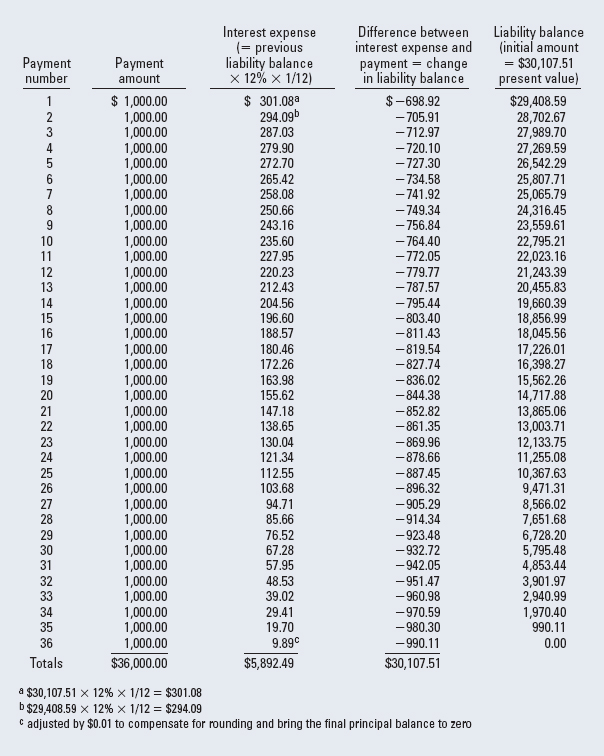
In addition, because the leased asset is being treated as if it had been purchased, the equipment must be depreciated. If title to the asset passes to the lessee at the end of the lease, the depreciation will be calculated in the usual way: the asset's useful life will be its physical life, and the residual value (if any) will be deducted. Otherwise, if title does not pass to the lessee at the end of the lease, the useful life of the asset will be limited to the term of the lease—since the company will not be able to use the asset after the lease ends—and any residual value will be irrelevant, because the lessee company will not get the residual value.
In this case, since there is no indication that title to the equipment passes to the lessee at the end of the lease, its useful life (for the lessee) will be equal to the lease term. Also, because the equipment will be returned to the lessor at the end of the lease, there will be no residual value (for the lessee); it must depreciate the entire value of the leased equipment.
If the company uses straight-line depreciation, the monthly depreciation will be $30,107.51 ÷ 36 months = $836.32, and the entry to record it will be as follows:
CAPITAL/FINANCE LEASE DEPRECIATION ENTRY
At the end of each month:
![]()
The impact of a lease transaction on the financial statements depends on its classification. On the statement of financial position, if the lease arrangement qualifies as a finance lease, both the company's assets and its liabilities will be higher than under an operating lease. On the statement of earnings, the company will report both depreciation expense and interest expense under a finance lease, compared to only equipment rental or lease expense under an operating lease.
In our example, if the lease is classified as a finance lease, the depreciation plus interest expense for the first month will be $836.32 + $301.08 = $1,137.40. By contrast, if the lease is classified as an operating lease, the expense will be $1,000. In the first month, therefore, classification as a finance lease results in higher expenses (and these would be even higher if the company used an accelerated method of depreciation).
The total expenses reported over the entire life of the lease will be the same, however, regardless of which method is used to record the lease transaction. If it is treated as an operating lease, the total expense will be $36,000 (36 payments of $1,000 each). If it is treated as a finance lease, the total expenses will also be $36,000 (consisting of $30,107.51 in depreciation and $5,892.49 in interest expense). The difference, then, is in the pattern of expense recognition over the life of the lease. Operating leases show the same amount of expense each period, while finance leases show more expense in the early periods (when interest charges, and perhaps depreciation, are high) and less expense in later periods.
Although no asset or liability is recorded under operating leases, companies with significant operating leases have to disclose their commitments to pay for these leases—as discussed in Chapter 9. Companies are required to disclose the future lease payments to be made in total and for each of the next five years. Finance lease obligations also require similar disclosures. The future payment obligations associated with leases would typically be shown in a note that relates either to long-term debt or to commitments.
accounting in the news
Lease Fights Prevent Hamilton Hockey Score
Although lease arrangements have several benefits for the lessee, the binding terms of the contract can be problematic—even in the hard-hitting world of the National Hockey League.
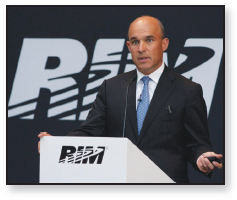
One of the main reasons cited for the failure of the 2007 bid by Research In Motion founder, Jim Balsillie, to bring the Nashville Predators to Hamilton, Ontario, was disputes regarding the Predators' arena lease. The NHL said the lease precluded approval of relocation and the league would only consider relocation as part of a sale in cases where a lease was expiring or could be broken unilaterally.
Even when the team filed for bankruptcy in May 2009, the City of Glendale, Arizona—which was then the home to the Predators franchise—objected to any relocation. Balsillie tendered an offer to buy the team after it filed for bankruptcy, still with the goal of moving it to Hamilton, where his experience with leases has been more positive. Indeed, the City of Hamilton voted unanimously to approve a 20-year arena lease agreement with Balsillie for the renovation and use of Copps Coliseum—but only if he eventually succeeds in bringing the hockey team there.
Sources: David Naylor, “Never in Hamilton,” Globe and Mail, July 14, 2007; Sean Fitz-Gerald, “Balsillie Gets Copps Coliseum Lease as Battle Looms, National Post, May 13, 2009.
Like many airlines, WestJet Airlines Ltd. leases some of its aircraft, as well as other assets such as land, buildings, and equipment. In WestJet's financial statements, the required disclosures are found in Note 12 for the operating leases and Note 8 for the finance (capital) leases. Excerpts from these notes are presented in Exhibit 10-6.
Notice that the overwhelming majority of WestJet's leases are operating leases rather than finance or capital leases. In fact, the total amount of payments due under its operating leases ($1,613,350 thousand CAD) is over 200 times the total due under its capital leases ($6,822 thousand).
IFRS INSIGHTS
The International Accounting Standards Board has been considering changes to lease accounting that, if adopted as IFRS, could have a significant impact on how leases are accounted for. It seems quite likely that a different accounting model will be adopted, and that the present requirements and practices in accounting for leasing arrangements will no longer apply.
PENSIONS
Pensions are agreements between employers and employees that provide the latter with benefits (income) upon retirement. To the extent that the company is obliged to make payments under these agreements, their costs should be recorded in the years when the company receives the benefits from the work of its employees. In other words, to be in accordance with the matching principle, pension costs should be recognized when the employees earn their pensions, not when they receive them. Two kinds of pension plans are commonly used by employers: defined contribution plans and defined benefit plans.
 EXHIBIT 10-6 WESTJET AIRLINES INC. 2009 ANNUAL REPORT
EXHIBIT 10-6 WESTJET AIRLINES INC. 2009 ANNUAL REPORT
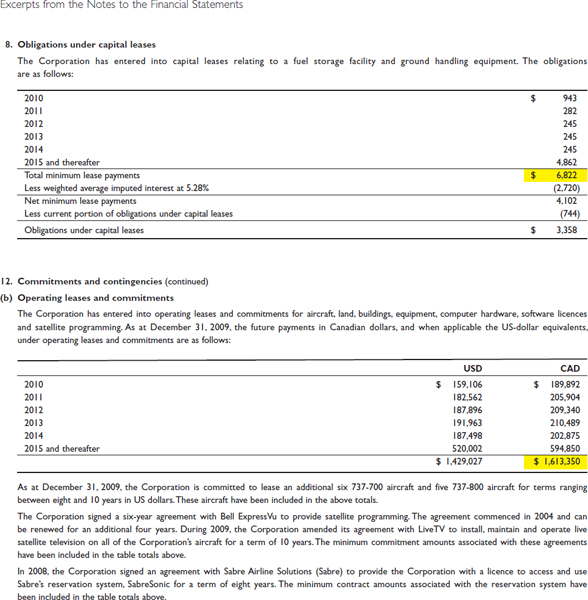
LEARNING OBJECTIVE 7
Explain the distinguishing features of defined-contribution pension plans and defined-benefit pension plans.
Defined Contribution Pension Plans
In a defined contribution pension plan, the employer agrees to make a specified (or defined) contribution to a retirement fund for the employees. The amount is usually set as a percentage of the employees' salaries. Employees sometimes make their own contributions to the same fund, to add to the amounts invested. The amount of the pension benefits that will be paid to the employees in their retirement depends on how well the investments in the retirement fund perform. The employer satisfies its obligation to the employees when it makes the specified payments into the fund. The fund is usually managed by a trustee (someone outside the company's employ and control), and the assets are legally separated from the company's other assets, which means they are not reported on the company's statement of financial position.
The accounting for defined contribution funds is straightforward. The company accrues the amount of its obligation to the pension fund, and then records a payment. Because the liability is settled, no other recognition is necessary in the financial statements. The entries to recognize the pension expense and the related payment are as follows:

Companies generally make cash payments that coincide with the accruals, because they cannot deduct the cost for tax purposes if the cash payment is not made. Therefore, with a defined contribution pension plan there is usually no liability balance to report.
Defined Benefit Pension Plans
A defined benefit pension plan is more complex. It guarantees to pay the employees a certain amount of money during each year of their retirement. The formula used to calculate how much will be paid usually takes into consideration how long an employee has worked for the company as well as the highest salary (or an average of the highest salaries) that the employee earned while working for the company. For example, a plan might specify that the employee will receive 2% of the average of the highest three years of salaries, multiplied by the number of years that the employee worked for the company. If the employee worked for the company for 30 years and had an average salary of $60,000 for the highest three years, the annual pension benefit would be $36,000 per year (2% × $60,000 × 30 years).
Of course, employees may leave the company at some point prior to their retirement. If the pension benefits belong to employees only as long as they work there, then there may be no obligation on the company's part to pay out pension benefits. In most plans, however, there is a provision for vesting the benefits. Benefits that are vested belong to the employees, even if they leave the company.
Because the payments to retired employees will occur many years in the future, pensions represent an estimated future obligation. In estimating the cost of the future obligation today (i.e., the liability's present value), several estimations and projections must be made. These include the length of time the employee will work for the company, the age at which the employee will retire, the employee's average salary during the highest salary years, and the number of years the employee will live after retiring. All these factors will affect the amount and timing of the future cash flows (pension payments). For companies with many employees, the total obligation of the pension plan usually has to be estimated based on the characteristics of the average employee rather than of particular employees. In addition, the company must choose an appropriate interest rate to use for calculating the present value of the future pension payments.
Each year, as employees work for the company, they earn pension benefits that oblige the company to make cash payments at some point in the future. Calculating the present value of the future pension obligation generally requires the services of an actuary. The actuary is trained in the use of statistical procedures to make the types of estimates required for pension calculations.
The accounting entries for defined benefit pension plans are essentially the same as the preceding entry for defined contribution plans. The company must accrue the expense and the related obligation to provide pension benefits. The amounts are difficult to estimate in the case of defined benefit plans, but the concept is the same as for defined contribution plans. The entry made to recognize the pension expense is called the accrual entry. Setting aside cash to pay for these future benefits is done by making a cash entry, which is sometimes called the funding entry. Many employee pension plan agreements have clauses that require the company to fund the pension obligation (i.e., to set aside funds to cover the liability). However, because of the uncertainties associated with the liability amounts, some companies have been reluctant to fully fund their pension obligations.
There is no accounting requirement that the amount expensed be the same as the amount funded. Therefore, the amount of pension expense that is recognized often differs from the amount of cash that is transferred to the trustee in a particular period. A net pension obligation will result if more is expensed than funded, or a net pension asset will exist if the funding is larger than the amount expensed. The calculation of the pension expense to be recorded each period involves many complex factors, and is beyond the scope of this book.
Pension funds are described as overfunded if the value of the pension fund assets held by the trustee exceeds the present value of the future pension obligations. In under-funded pension plans, the value of the pension fund assets is less than the present value of the future pension obligations. Pension plans in which the fund assets equal the present value of the future obligations are called fully funded. The pension fund itself is usually handled by a trustee, and contributions to the fund cannot be returned to the employer except under extraordinary circumstances. To provide sufficient funds to pay the pension benefits, the trustee invests the cash that is transferred to the fund. The trustee then pays benefits to the retired employees out of the pension fund assets.
Pension Plan Disclosures
In Canada, for a defined contribution pension plan, the contribution amounts for the period must be disclosed. For a defined benefit plan, the required disclosures are very extensive. Rather than list all the requirements, we will look at the disclosures provided by West Fraser Timber Co. Ltd. in Exhibit 10-7. West Fraser Timber has both defined benefit and defined contribution pension plans, as well as some health care and life insurance benefits that it provides to its retired employees.

accounting in the news
Miners Go on Strike over Changes to Pension Plan
Defined benefit versus defined contribution pension plans were at the heart of the longest nickel strike in Canadian history, in Sudbury and Port Colborne, Ontario. The conflict between the mining company Vale and the United Steelworkers union lasted just under a year, and ended only after both sides made concessions. Among the employees' concessions was acceptance of a change to their pension plan. Under the new labour agreement, new employees will join a defined contribution plan, which is funded by a percentage of the employees' salaries, instead of a defined benefit pension plan, which is funded by the company rather than workers' contributions.
The company's pension plan deficit of about $730 million at the end of 2008 was one of the reasons the giant Brazilian mining company needed to make this change. Many defined benefit plans faced shortfalls when the recession hit, then took an additional beating as financial markets collapsed. These shortfalls can seriously affect a company's finances, since the company is required to put more cash into the plan to keep it solvent.
Sources: “Vale Pension Plan Short $729 million,” Thestar.com, February 1, 2010; Peter Koven, “Vale Workers Ratify New Contract,” Financial Post, July 9, 2010.
The note discloses that, for its defined benefit pension plans, West Fraser Timber's pension expense for 2009 was $33.4 million and its funding contributions were $92.6 million. For its defined contribution pension plans, both its pension expense and its funding contributions for 2009 were $1.8 million. Also, the latter part of the note discloses some of the key estimates that have been made regarding the pension plans. For example, West Fraser Timber assumed that its pension plan investments would earn an average annual rate of return of 7%, and that employees' compensation would increase at an average annual rate of 3.5%.
Perhaps the most important thing to note about pensions is that, for defined benefit plans, the amount of any pension plan asset or liability that appears on the company's statement of financial position does not represent the plan's funding status. Because of the complex procedures involved in accounting for pension plans (which are beyond the scope of an introductory text), a company might report a net pension plan asset on its statement of financial position, even though its pension plan is underfunded. Conversely, a company might report a net pension plan liability on its statement of financial position, even though its pension plan is overfunded. To determine whether a company's pension plan is underfunded, overfunded, or fully funded, users must read the notes to the financial statements.
EXHIBIT 10-7 WEST FRASER TIMBER CO. LTD. 2009 ANNUAL REPORT
WEST FRASER TIMBER CO. LTD. 2009 ANNUAL REPORT

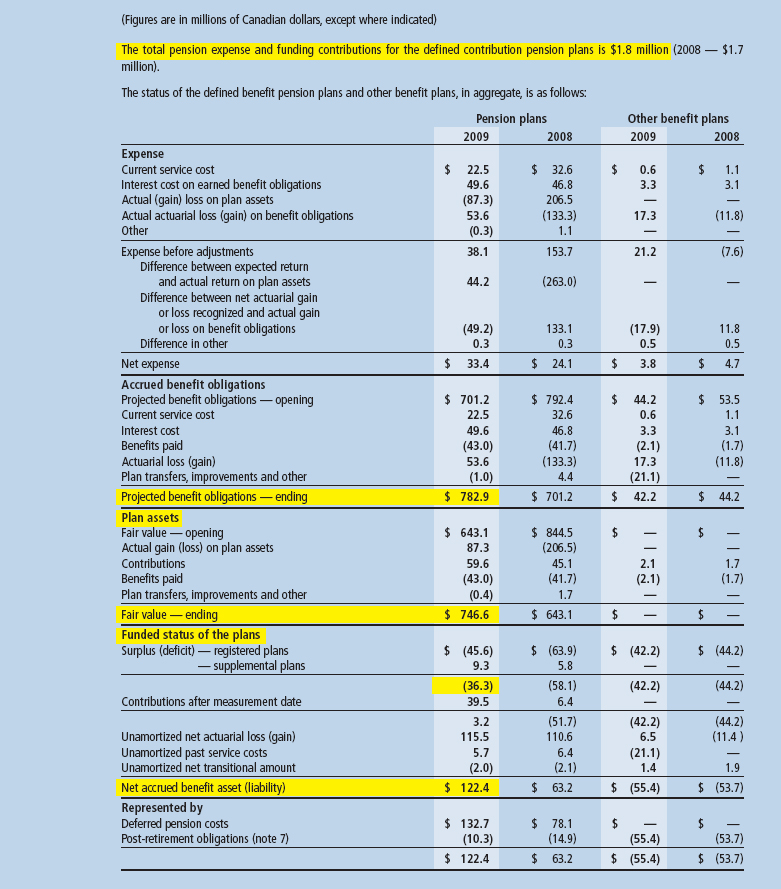

LEARNING OBJECTIVE 8
Outline the accounting issues in the reporting of pension plan liabilities.
For example, Exhibit 10-7 shows the following for West Fraser Timber's defined benefit pension plans at the end of 2009 (in millions):

Despite the fact that its pension plans were underfunded by $36.3 million—which implies that the company has a liability for this amount—Exhibit 10-7 shows that a net pension plan asset of $122.4 million was recorded in West Fraser Timber's accounts. On its balance sheet (presented in Exhibit 10-8), this is split between the non-current asset deferred pension costs of $132.7 million, and a non-current liability post-retirement obligations of $10.3 million (which is included in “Other liabilities”). This illustrates the importance of reading the notes to financial statements.
IFRS INSIGHTS
The International Accounting Standards Board has proposed changes to pension accounting that, if adopted as IFRS, could have a significant impact on how pensions are accounted for. In particular, they could greatly reduce or eliminate the smoothing that has commonly occurred in the past because companies were allowed to recognize the effects of changes in the values of their pension plan assets and/or pension benefit obligations gradually, over extended periods of time.
 EXHIBIT 10-8 WEST FRASER TIMBER CO. LTD. 2009 ANNUAL REPORT
EXHIBIT 10-8 WEST FRASER TIMBER CO. LTD. 2009 ANNUAL REPORT

LEARNING OBJECTIVE 9
Describe other post-employment benefits and explain how they are treated in Canada.
OTHER POST-EMPLOYMENT BENEFITS
As you just saw with West Fraser Timber, employers sometimes offer other types of post-employment benefits to their retirees, in addition to pensions. Health care benefits and life insurance are two of the most commonly offered benefits. Until recently, the obligation to provide these benefits was, for the most part, ignored in the financial statements of Canadian companies. Because of publicly funded health care in Canada, corporate obligations and exposure (risk) were limited. Therefore, the costs of providing these benefits were recorded on a pay-as-you-go basis; that is, the costs were expensed as the cash was paid out to the insurance companies that provide the benefits. However, companies are now required to account for these post-employment items in much the same way as they account for pensions.
LEARNING OBJECTIVE 10
Explain why deferred/future income taxes exist, and describe how they are reported.
DEFERRED INCOME TAXES
Deferred income taxes (also known as future income taxes) arise because companies use two different systems for calculating their taxes. They use accounting standards for revenues and expenses to determine income tax expense on their statement of earnings, and they use Canada Revenue Agency (CRA) calculations of revenues and expenses to determine their income tax payable (that is, the amount of tax that must actually be paid to the government). In other words, companies prepare their financial statements according to the requirements of generally accepted accounting principles, but they prepare their income tax returns (which determine the amount of tax they have to pay each year) according to the requirements of the Income Tax Act and regulations. Differences between these two sets of calculations result in deferred income tax assets and liabilities.
For example, in Chapter 8 we discussed deferred income taxes because companies can use any one of several depreciation methods for accounting purposes but must use capital cost allowances (CCA) for tax purposes. The use of different methods for preparing financial statements and tax returns results in balances in companies' accounting records that are different from the balances in their tax records. These different balances result in deferred income tax effects.
Another area that creates differences between what is reported in the accounting system and what is reported on a company's tax return is warranty costs, which we discussed in Chapter 9. For accounting purposes, the warranty expense deducted from income includes an estimate of future warranty costs, based on the revenue that was recognized in the current period. For tax purposes, however, only the actual amount that the company paid to repair items under warranty during the current period is allowed as a tax deduction.
There are also many other differences between accounting standards and tax regulations that give rise to deferred income taxes.
In Canada, the liability method is used to measure deferred income taxes. This method tries to measure the liability that will be incurred to pay more tax in the future, or the benefit that will be derived from paying less tax in the future, that is created by the differences between accounting calculations and tax calculations. Once the tax that is currently owed to the CRA and the deferred income tax have been calculated, the tax expense equals these two items combined (i.e., the income tax expense equals the income tax currently payable plus or minus the deferred income tax amount).
LEARNING OBJECTIVE 11
Record deferred/future income taxes in simple situations.
To illustrate the calculation of deferred income taxes, we will use the data in Exhibit 10-9 for a company that sells products with a three-year warranty. For simplicity, we will assume that the warranty is the only source of difference between the company's accounting records and its tax records.
For accounting purposes, the company estimates the probable costs associated with the warranty and records the total amount as warranty expense in the year of the sale, as well as a liability (warranty obligation). For tax purposes, however, the CRA does not permit a company to deduct the estimated warranty expense in calculating its taxable income; the company can only claim a tax deduction for the actual costs that it incurs each year to settle claims under the warranty.

The liability method requires a calculation of the income tax that will be payable in the future, based on the temporary differences (the differences between the accounting records and the tax records) that exist in the current period. In the case of warranties, the company's accounting balances include a warranty liability which represents amounts that will be tax deductions in future periods, when the warranty claims will be paid and deducted on the company's tax returns. This creates a deferred (or future) income tax asset, because fewer taxes will be paid in the future when these amounts are deducted on its tax returns. Exhibit 10-10 illustrates how this occurs.
In part “b” of Exhibit 10-10, for year 1 there is an initial $500 warranty obligation in the accounting records less the actual warranty costs of $125 in the tax records, resulting in a $375 temporary difference (the warranty obligation balance) that is carried forward to year 2. Next, still in year 1, the amount of the reduction in future taxes is calculated. This is done by taking the ending warranty obligation balance (the temporary difference) and multiplying it by the company's tax rate. The $375 balance from year 1 is multiplied by the company's tax rate of 40%, and the result indicates that in future years the company's taxes payable will be reduced by $150 as actual warranty costs are claimed as tax deductions. This amount is then recorded as a deferred income tax asset, to keep a record of the future tax benefits (savings).
In year 2 when this calculation is repeated (using the warranty liability balance carried over from year 1 and the actual warranty costs of year 2), the balance in the deferred income tax asset account is reduced to the amount of tax deductions that remain to be claimed in year 3. The process is then repeated in year 3, until, in our example, the warranty obligation balance has been reduced to zero. At this point, the balance in the deferred income tax account is also zero.
Part “c” of Exhibit 10-10 shows the last step in the income tax calculations, which is to calculate the company's income tax expense. This is done by subtracting the change in the balance of the deferred income tax account (in part “b”) from the amount of actual taxes payable to the CRA (in part “a”). Thus, for year 1, we subtract $150 from the $3,950 of income tax payable to arrive at an income tax expense of $3,800 for the year. (An important distinction must be noted here: income tax expense is not the same as income tax payable. Income tax payable is the amount of money that the company currently has to pay to the CRA. Income tax expense includes both the amount of tax that is currently payable and the change in the amount of tax that is deferred to the future.)
EXHIBIT 10-10 INCOME TAX CALCULATIONS
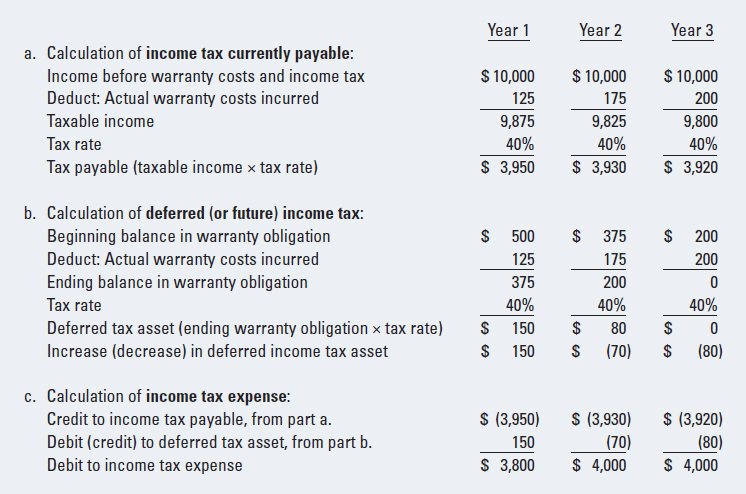
The journal entries to record the income taxes calculated in Exhibit 10-10 are as follows:

HELPFUL HINT
Note that the income tax currently payable and the change in the deferred income tax are calculated first; then the tax expense is simply the amount that will make the journal entry balance.
It should be noted that, to keep the example simple, we created a single warranty obligation in year 1 and then traced it through years 2 and 3. In reality, there would be more sales of products with warranty provisions in years 2 and 3. These new sales would create new warranty obligations, and additional deferred taxes. Dealing with multiple years makes the calculations significantly more complex, but the concept remains the same. Warranty obligations are recognized for accounting purposes in the year of the sale and actual costs are deducted for tax purposes as the obligations are settled. As a result, a deferred tax asset is created in the year of the sale and eliminated over the next two years (because the warranty in our example is for three years).
In Chapter 8, there is an example of deferred income taxes arising from the use of depreciation for accounting purposes versus CCA for tax purposes. You should review the illustration in Exhibit 8-7 and the related discussion on pages 529–530.
Some users misunderstand deferred income taxes, especially if there is a credit balance and it is included with the long-term liabilities. They mistakenly assume that these deferred income taxes represent amounts that are currently owed by the company and should be paid. This assumption is incorrect, because the amount that is currently owed is shown elsewhere—as taxes payable, under current liabilities. Deferred income tax credits on the statement of financial position represent amounts that will be owed in the future as a result of current operations. If, as illustrated in Chapter 8, we take the example of deferred income taxes arising because CCA is used for tax purposes while straight-line depreciation is used for accounting purposes, in the early part of an asset's life the tax deduction (CCA) will be larger than the accounting expense (depreciation). This means that the company will pay less tax in the early part of the asset's life. However, in the latter part of the asset's life the CCA deductions will be smaller, which means that the company will have to pay more tax at that time. This is what a credit balance in deferred income taxes represents.
Previously, deferred or future income taxes could appear in various parts of the statement of financial position: as current assets, current liabilities, non-current assets, or non-current liabilities. However, under IFRS they must be classified as non-current. When they have a debit balance, they are reported as non-current assets; more commonly they have a credit balance and are reported as non-current liabilities.
Referring back to Exhibit 10-8 on page 660, you will see that West Fraser Timber has future (deferred) income taxes as an account title in two places on its balance sheet. It reports a future tax liability for both 2008 and 2009 ($266.8 and $217.2 million, respectively) grouped with long-term liabilities, and in 2008 it also reports future income taxes of $87.2 million as a non-current asset.
As Exhibit 10-8 illustrates, deferred or future income taxes can be very significant amounts on the statement of financial position. In West Fraser Timber's case, its liability for future income taxes was almost 20 percent of its total liabilities. It is therefore important that users understand what these deferred or future income taxes are. Deferred income tax liabilities represent amounts related to past operations that are expected to become payable in the future. Deferred income tax assets, on the other hand, represent expected future benefits in the form of lower income taxes to be paid in the future, as a result of higher taxes having been paid in the past.

INTERNATIONAL PERSPECTIVES
There are many differences in accounting for income taxes in various parts of the world. In some countries, accounting practices follow the income tax requirements. In these cases, since there are no differences between accounting balances and tax amounts, no deferred income taxes arise. In many other countries, income tax expense is recorded based on a company's taxable income rather than its accounting income. Therefore, no deferred income taxes arise in these cases, either.
OTHER INCOME TAX DISCLOSURES
A number of additional disclosures related to income taxes are usually included either on the financial statements or in the accompanying notes. Although most of these are beyond the scope of an introductory text, we will examine two of the main types.
One of the key tax disclosures is a breakdown of the tax expense (or provision for income taxes) into the amount that is currently payable and the amount that is deferred to the future. To illustrate this, a portion of the consolidated statement of earnings for West Fraser Timber is reproduced in Exhibit 10-11.
EXHIBIT 10-11 WEST FRASER TIMBER CO. LTD. 2009 ANNUAL REPORT
WEST FRASER TIMBER CO. LTD. 2009 ANNUAL REPORT

Notice that, of West Fraser Timber's total tax expense of $83.3 million for 2008, $18.8 million was to be paid currently and the remaining $64.5 million was expected to become payable in future periods. For 2009, its total tax expense of $31.7 million consisted of $57.7 million that was to be paid currently and an offsetting $26.0 million that was expected to be recovered in future periods. In other words, although West Fraser Timber calculated that its income tax expense for 2009 was $31.7 million, under the tax regulations it was required to make a tax payment of $57.7 million. However, its income taxes that will be payable in future periods are expected to be reduced by $26.0 million.
Another key tax disclosure in the notes is the summary of the temporary differences that have created the deferred income tax amounts. This is illustrated in Exhibit 10-12, which presents Note 14 to West Fraser Timber's financial statements.
Notice that the biggest single source of temporary differences (and hence future taxes) for West Fraser Timber is, as one would expect, differences between the depreciation on its property, plant, equipment and timber, for accounting purposes, and its capital cost allowance claims on these assets, for income tax purposes. Due to the resulting differences between the net book values of these assets in the company's accounts and their undepreciated capital costs in its tax records, West Fraser Timber expects that it will have to pay additional income taxes of $234.7 million in the future. However, there are various other temporary differences listed in the note that partially offset this; consequently, the company reports a net future income tax liability of $217.2 million on its balance sheet.
IFRS VERSUS ASPE
Under current Canadian accounting standards for private enterprises (ASPE), businesses that are privately held are not required to record deferred income taxes; they have the option of simply recording income tax expense equal to the amount of income tax payable each period.
 EXHIBIT 10-12 WEST FRASER TIMBER CO. LTD. 2009 ANNUAL REPORT
EXHIBIT 10-12 WEST FRASER TIMBER CO. LTD. 2009 ANNUAL REPORT
STATEMENT ANALYSIS CONSIDERATIONS
Two ratios that are commonly used to evaluate a company's ability to repay its obligations are the debt to total assets ratio and the times interest earned ratio. Exhibit 10-13 presents the statement of earnings and balance sheet of WestJet Airlines Inc., which we will use to demonstrate how these two ratios can provide insights into the financial structure and risk of a company.
The formula for the debt to total assets ratio is simply:

EXHIBIT 10-13A WESTJET AIRLINES LTD. 2009 ANNUAL REPORT
WESTJET AIRLINES LTD. 2009 ANNUAL REPORT
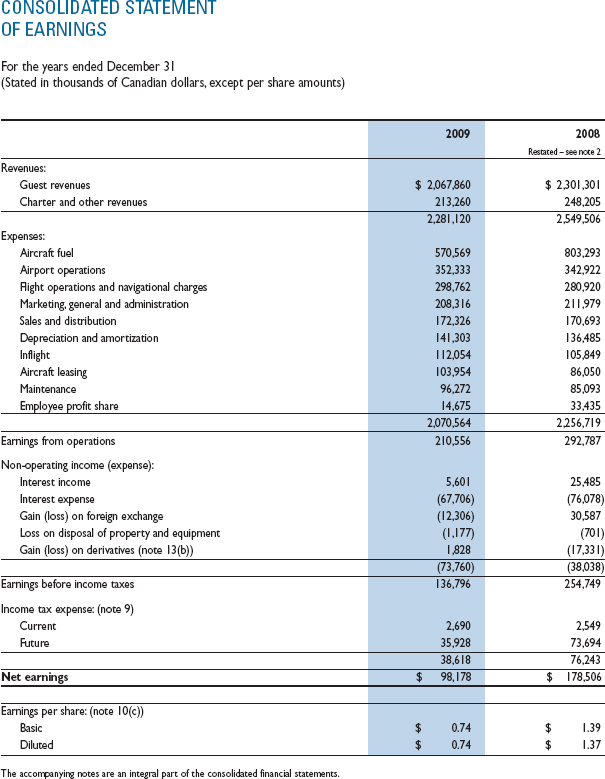
 EXHIBIT 10-13B WESTJET AIRLINES LTD. 2009 ANNUAL REPORT
EXHIBIT 10-13B WESTJET AIRLINES LTD. 2009 ANNUAL REPORT
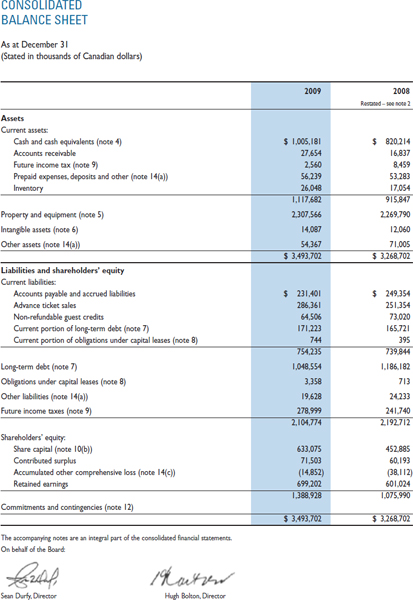
The 2009 and 2008 debt to total assets ratios for WestJet are as follows:

These calculations reveal that in 2008, 67.1% of WestJet's assets were financed through debt. The ratio dropped a little in 2009, to 60.2%. From the company's balance sheet, we can see that there was a slight increase in WestJet's current liabilities but a greater decrease in its non-current liabilities, resulting in a reduction of approximately $88 million in its overall debt; at the same time, its assets increased by $225 million. In short, WestJet was able to increase its assets without increasing its debt, which reduces the financial risk of the company. It would be important to continue to follow this ratio before drawing conclusions about any major shifts in the company's financing strategy.
The times interest earned ratio provides a measure of the company's ability to cover its interest expense out of its earnings, by calculating how many times the earnings that are available to cover the interest exceed the interest itself. It is normally calculated as follows:

The specific calculation required to determine the earnings available to cover the interest charges for a particular company will depend on the format of its statement of earnings. WestJet discloses earnings from operations, an amount that is before interest and taxes (as well as before any other non-operating revenues, expenses, gains, and losses), so in this case it is not necessary to perform a calculation to get the earnings available to cover the interest. The 2009 and 2008 times interest earned ratios for WestJet are as follows:

In 2008, WestJet's earnings available to cover interest were almost four times the amount of its interest expense. This indicates that its earnings from operations could fall by about three-quarters before it would be unable to cover its interest charges. Whether this is an adequate cushion depends on the company's line of business and the variability of its earnings. In 2009, the ratio decreased to about three times, indicating that WestJet's earnings from operations could fall by about two-thirds before it would be unable to cover its interest expense.
Thus, the ratio results indicate that WestJet's ability to cover its interest charges deteriorated somewhat. Even though its interest expense decreased in 2009—likely due to the decrease in long-term liabilities noted in the debt to total assets ratio—its earnings from operations decreased even more, leaving the company less able to cover its interest charges in 2009 than in 2008. Creditors would watch this ratio for indications that WestJet might become unable to make its scheduled interest payments. They would also read the note describing long-term debt to see if interest costs will continue to decrease, or if any additional debt is taken on that will increase the interest expense and further decrease the ratio.
LEARNING OBJECTIVE 12
Calculate the debt to total assets ratio and the times interest earned ratio, and comment on a company's financial health using the information from these ratios.
The biggest concern for most analysts regarding debt is the possibility of unrecorded liabilities. As we saw in the last chapter, commitments and contingent liabilities can have significant effects on a company's health. In this chapter, a company's obligations under operating leases are an example of liabilities that are not reported on the financial statements. Unrecorded liabilities will cause debt ratios to be understated and times interest earned ratios to be overstated. Fortunately, certain disclosures give analysts some help in understanding the effects of these unrecorded liabilities. For example, the disclosure of the next five years of lease payments for operating leases allows analysts to approximate the present value of these lease payments for inclusion in ratio analysis.
In Exhibit 10-6, we saw that WestJet had total commitments of $1,429,027 million related to operating leases. This amount is greater than the total long-term liabilities reported on WestJet's balance sheet. Although the amount disclosed in the notes for the operating leases is not discounted (i.e., not reported at its present value, as other long-term liabilities are) and therefore any direct comparison to the liabilities on the balance sheet is only an approximation, it is clear that if the present value of those obligations were recorded on the balance sheet the ratio of debt to total assets would increase substantially. The times interest earned ratio would also be affected by the portion of the lease payments determined to be interest expense. The effects of other commitments and off-balance-sheet liabilities may be more difficult to estimate, so analysts need to have a good understanding of the company, including its operating, investing, and financing activities, and the types of contracts it enters into, so that these obligations do not come as surprises.
Another concern is whether the carrying values of liabilities reflect their current market values. Because liabilities are recorded at the interest rates that were in effect when the debt originated, changes in market interest rates can cause changes in the value of these liabilities that may not be reflected on the company's books. This does not mean that the company will be paying more or less interest as a result of the changes in market interest rates, but it does mean that the company may be paying more or less than it would if it took out new debt at current rates. Debt carrying values can be adjusted to their fair values either by looking at the debt's market value (for publicly traded debt) or by recalculating the debt's present value using current market interest rates. This, of course, requires detailed information about the terms of the outstanding debt. Another reason why it is important for users to know about changes in interest rates is that companies often refinance their debt, and users need to know what the potential costs are to the company the next time it uses debt financing.
Another risk that analysts should consider is the one posed by debt that is denominated in a foreign currency. As you can imagine, if the company is required to make debt payments in a foreign currency, fluctuations in the exchange rate for that currency can cause increases or decreases in the amount of the liability as expressed in Canadian dollars.
A further risk is that the company may enter into debt agreements in which the interest is not a fixed rate, but floats with interest rates in the economy (sometimes called variable-rate debt). If interest rates go up, the company can find itself having to make significantly higher interest payments. Both these risks can be managed through the use of sophisticated hedging techniques involving financial instruments, such as interest rate and foreign currency options, and swaps. To help readers of financial statements understand these complex transactions and the risks posed to the company, companies in Canada are required to disclose these types of transactions and to provide details concerning the risks that the company faces because of them.
SUMMARY
This chapter completes the discussion of liabilities that started in Chapter 9. Because of the larger amounts being borrowed, the longer time frame involved, and the uncertainty of the future, the risks associated with long-term liabilities are more extensive than those associated with the short-term liabilities discussed in the previous chapter.
The first portion of this chapter outlined different sources of long-term financing available to a company, including borrowing through long-term notes and mortgages. The accounting for these forms of long-term debt is relatively simple, and parallels the accounting for short-term notes that was discussed in Chapter 9.
Large companies often use bonds as a way of raising additional funds for financing growth. Depending on the gap (if any) between the interest rate being offered by the company and the rate being offered in the market for comparable bonds issued by other companies, a company's bonds may be issued at par (face value), above par (at a premium), or below par (at a discount). The chapter described how the issuance price for bonds is established through the use of present value calculations, and how bonds are accounted for, from issuance to retirement.
Another topic discussed in the chapter was leasing—a financing alternative that is used extensively in Canada. When a company needs to acquire or replace a capital asset, it will consider whether it is more advantageous to buy the asset or to lease it. The details of the leasing contracts determine whether they can be accounted for as operating leases or must be accounted for as finance leases. The accounting treatment for each of these types of leases is very different, and was illustrated in the chapter.
Pensions and other post-employment benefits were also discussed, as most large organizations in Canada have pension plans for their employees. The two basic types of pension plans—defined contribution plans and defined benefit plans—were described. We did not go into extensive detail about the accounting for pensions, but rather tried to give you an understanding of what the main issues are and how pension plan information is reported in the financial statements.
Because both leases and pensions are often large items that can have significant effects on the financial statements but may not appear directly in them, knowledge of an organization's lease contracts and pension plans is essential to any evaluation of its current financial position and future prospects.
The final major item in the chapter was a discussion of deferred income taxes, building on the introduction to this topic in Chapter 8. Deferred income taxes are significant amounts in many companies' financial statements, and are often a confusing item for users because they can be either an asset or a liability.
The chapter concluded with a discussion of two ratios that are important in relation to debt: the debt to total assets ratio and the times interest earned ratio. These ratios provide users with a basis for analyzing some of the risks associated with debt financing.
The discussion of specific components of the statement of financial position concludes in the next chapter, with a discussion of shareholders' equity. Following that, we will provide a complete review of the ratios introduced throughout this book and introduce some additional analytical techniques.
Additional Practice Problems
PRACTICE PROBLEM 1
Ling Limited issues bonds with a face value of $100,000 and a bond interest rate of 8% on January 1, 2011. The bonds mature in 10 years and pay interest semi-annually on June 30 and December 31.
Required:
- If the competitive interest rate (or yield) for similar bonds in the market is 6%, how much will investors be willing to pay for these bonds?
- If the bonds are issued at the price calculated in part “a,” what journal entries will Ling Limited make in 2011 to account for these bonds?
- If the market interest rate (or yield) for similar bonds is 10% (instead of 6%), how much will investors be willing to pay for these bonds?
- If the bonds are issued at the price calculated in part “c,” what entries will the company make in 2011 to account for these bonds?
STRATEGIES FOR SUCCESS:
- Begin by calculating the amount of interest that will be paid out each six months. Remember that this is based on the face value of the bonds using the bond interest rate.
- Calculate the issuance price using the present value tables printed on the inside covers, a financial calculator, or the Excel function described in the Appendix following these practice problems. If necessary, refer to the section on bond pricing (pages 637–640) for a refresher on how to do this.
- Calculate the interest expense for June 30 by multiplying the bond issuance price (the one you calculated using the present value tables) by the yield rate. The difference between the amount of interest paid in cash and the amount of interest expense is recorded as a debit or a credit to the bond liability account, to make the journal entry balance.
- Calculate the interest expense for December 31 by multiplying the new amount of the bond liability by the yield rate. As before, the difference between the amount of interest paid and the amount of interest expense is recorded as a debit or a credit to the bond liability account, to make the journal entry balance.
PRACTICE PROBLEM 2
On January 1, 2011, Acme Company Ltd. enters into a five-year lease for a computer system. The fair value of the computer system is $35,000. At the end of the lease term, the system will be returned to the lessor, who estimates that it will have no residual value. The lease contract calls for payments of $778.56 at the end of each month. These payments will provide the lessor with a 12% return on the lease contract.
Required:
- Based on the above facts, how should Acme account for this lease?
- Construct the entries that Acme should make during the first two months of the lease.
- Give some reasons why Acme would choose to lease the computer system rather than buy it.
- Refer back to the section on leases (pages 647–652), where there were criteria listed for determining whether a lease is an operating lease or finance lease. Read the information about the lease carefully, to see whether any of the finance lease criteria fit for Acme Company. If so, it is a finance lease.
- Calculate the present value of the lease using the lease payments ($778.56), the interest rate for one month (12% per year ÷ 12 months), and the duration of the lease in months (12 months per year × 5 years). If you use the tables printed on the inside covers, you will need to use Table 1.
- The amount of interest expense incurred for the first month is calculated using the present value of the lease that you determined above.
- The interest expense for the second month is calculated using the balance of the lease obligation at the end of the first month (i.e., the original present value of the lease less the changes that you made to the lease obligation account in the first month).
PRACTICE PROBLEM 3
Exhibit 10-14 shows part of the pension footnote for Teck Cominco Ltd., an integrated Canadian natural resource corporation involved in mineral exploration, mining, smelting, and refining.
Required:
- What kinds of pension plans does Teck Cominco have?
- How is Teck Cominco accounting for its non-pension retirement benefits? Does its funding match the recognition of the expense for these benefits? Explain.
- On its income statement, Teck Cominco does not disclose the total expense for retirement benefits. On the balance sheet, it lists “Other liabilities” of $1,029 million. In the notes, it states that this amount includes an accrued pension liability of $54 million for the defined benefit pension plan and $266 million for other post-retirement benefits. What information does this give users about Teck Cominco's retirement benefit plans?
EXHIBIT 10-14 TECK COMINCO LTD. 2009 ANNUAL REPORT
TECK COMINCO LTD. 2009 ANNUAL REPORT
Excerpts from the Notes to the Financial Statements
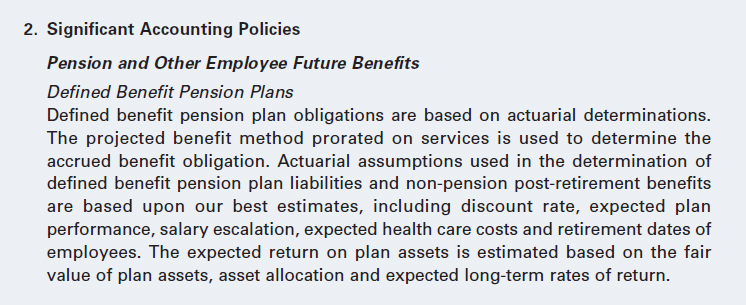
STRATEGIES FOR SUCCESS:
- Read each of the questions and then carefully read the note to the financial statements. You should be able to find the answers in the note.
- If necessary, reread the sections on pensions and other post-employment benefits (pages 655–661).
PRACTICE PROBLEM 4
Lund Company purchased a piece of equipment on January 1, 2011, for $41,000. For accounting purposes, the company will depreciate this asset by the straight-line method over its useful life, which is estimated to be eight years. The residual value is estimated to be $1,000. The asset qualifies as a class 10 asset for tax purposes, with a 30% CCA rate. During 2011, Lund generated $18,500 in income before depreciation and taxes. The tax rate in 2011 is 40%. The depreciation of this asset is the only difference between Lund's accounting methods and the tax methods.
Required:
- Calculate the income taxes payable for 2011 and the deferred income tax liability at the end of 2011. Then construct the journal entry that Lund will make in 2011 to record its taxes.
- What income tax amounts should be reported on the company's 2011 statement of financial position, and how should they be classified?
- Prepare a note related to income taxes to accompany the 2011 financial statements.
STRATEGIES FOR SUCCESS:
- Begin by calculating the depreciation expense and the capital cost allowance (CCA) for the year. Remember that the CCA claim for the first year of an asset's life is only half the usual amount.
- Using the CCA, determine the taxable income for the year. Then multiply this by the tax rate, to calculate the income taxes that are currently payable.
- Determine the difference between the undepreciated capital cost of the equipment (Cost − CCA) and its net book value (Cost − Depreciation). Then multiply this by the tax rate to calculate the deferred income taxes.
- If the equipment's undepreciated capital cost is higher than its net book value, the deferred income tax will be an asset. If the undepreciated capital cost is lower than the net book value, the deferred income tax will be a liability.
- If necessary, reread the section on deferred income taxes (pages 661–664).
SUGGESTED SOLUTION TO PRACTICE PROBLEM 1

a. Present value of the Ling Limited bonds at a yield rate of 6%:

This is the amount that will be received when the bonds are issued.
b.

c. Present value of the bonds at a yield rate of 10%:

d.
SUGGESTED SOLUTION TO PRACTICE PROBLEM 2
- Since the computer system will have no value at the end of the five-year lease term, the lease covers all of the asset's useful life. Therefore, Acme should account for it as a capital asset acquired under a finance lease.
- The following entries should be made in the first two months.
The present value of the lease payments at 12% per year over 60 months is equal to $778.56 × 44.95504 (Table 1, PV factor for 60 periods at 1%) = $35,000.
JOURNAL ENTRY FOR INCEPTION OF LEASE ON JANUARY 1, 2011

Each month, the interest expense on the outstanding lease obligation and the monthly lease payment must be recorded, with the difference between these two amounts reducing the principal amount. Because this is an annuity in arrears, the payment reduces the principal of the obligation at the end of the month. The following entries would be made:
JOURNAL ENTRY FOR INTEREST AND LEASE PAYMENT ON JANUARY 31, 2011

Assuming that the corporation depreciates its leased assets on a straight-line basis over the lease term, the following entry would also be made at the end of each month:
JOURNAL ENTRY FOR DEPRECIATION ON JANUARY 31, 2011

JOURNAL ENTRY FOR INTEREST AND LEASE PAYMENT ON FEBRUARY 28, 2011

JOURNAL ENTRY FOR DEPRECIATION ON FEBRUARY 28, 2011

- There are several reasons why Acme might choose to lease the computer system.
- Acme may not have $35,000 available to buy the system. Rather than borrow the $35,000 from the bank, it may choose to lease the asset and make monthly payments.
- The interest rate charged on the lease may be less than what the bank would charge, and/or the duration of the lease financing may be longer than what the bank would provide.
- Because Acme does not own the computer system, if something goes wrong with the system the lessor is responsible for fixing it. It is likely that the lease agreement includes clauses that outline the types of problems that the lessor agrees to fix and the types (if any) that are Acme's responsibility.
- At the end of the five years, Acme is required to return the system to the lessor. This means that it will have to replace it. Thus, the end of the lease term forces Acme to stay technologically current (if you assume that five years is not too long to keep a computer system without replacing it).
- There may be clauses in the lease agreement about upgrades to the system and who is responsible for making the upgrades. If the lessor is responsible, it may be to Acme's advantage to lease the system.
SUGGESTED SOLUTION TO PRACTICE PROBLEM 3
- Teck Cominco Ltd. appears to have both defined benefit and defined contribution pension plans. For its defined benefit pension plans, it mentions actuarial assumptions and the basis of those assumptions. For its defined contribution pension plans, it states that the costs of providing the benefits are charged to earnings as the obligation to contribute is incurred. For these plans, there is no need for information about assumptions, because the amount of the obligation is easily determined.
- Teck Cominco Ltd. is accounting for its post-employment benefits by accruing them as the employees are working (using methods similar to those for defined benefit pension plans) but not funding them until they become due. The funding is not matching the expense, as the company is not putting any funds aside to cover these costs when the employees retire.
- Teck Cominco Ltd. is telling users that its pension plans and other post-retirement benefits are not fully funded. The amount Teck Cominco has expensed for these items is greater than the amount that it has deposited in funds to pay for those future benefits.
SUGGESTED SOLUTION TO PRACTICE PROBLEM 4
- The taxes payable for 2011 and the deferred income tax liability are calculated as shown below.
Depreciation calculation:
($41,000 − $1,000) ÷ 8 = $5,000 per year
The net book value of the asset at the end of 2011 is $41,000 − $5,000 = $36,000. This is the asset's carrying value for accounting purposes.
CCA calculation:
$41,000 × 30% × 50% (for the first year of the asset's life) = $6,150
The undepreciated capital cost at the end of 2011 is $41,000 − $6,150 = $34,850. This is the asset's carrying value for tax purposes.
Since the asset's carrying value for tax purposes is lower, there will be lower tax deductions (in the form of CCA) available in the future. Consequently, the company will have to pay more tax in the future; in other words, a deferred income tax liability exists.
Calculation of taxes currently payable:

Calculation of deferred income taxes:
$36,000 − $34,850 = $1,150 difference between the asset's carrying value for accounting purposes and its carrying value for tax purposes.
The deferred income tax liability is $1,150 × 40% tax rate = $460.
Journal entry for income taxes in 2011:

- Income taxes payable of $4,940 should be reported as a current liability. Deferred income taxes of $460 should be reported as a long-term liability.
- The following note regarding income taxes could be included with Lund Company's financial statements:
Income taxes for 2011 consist of:

Deferred income taxes have arisen as a result of temporary differences from claiming capital cost allowance for income tax purposes in excess of depreciation expense for accounting purposes. At the end of 2011, these capital assets had a net book value of $36,000 and an undepreciated capital cost of $34,850, resulting in a deferred income tax liability of 40% × ($36,000 − $34,850) = $460.
APPENDIX
Using Excel to Calculate Present Value
The Present Value function within Microsoft® Excel provides an easy way to find the present value of a series of numbers (an annuity, like the interest payments on a bond) and/or a single number (like the principal repayment on a bond). Excel has several formula functions embedded within it, one of which is present value.
The present value function can be accessed in two ways. First, you can access it through the following steps: open Excel and click on any cell. From the tool bar, select Insert and then Function. Once you are within Function, you will see a list of all of the functions within Excel. Select the PV function. The following box will pop up.

You can type the information in the boxes to determine the present value of a series of interest payments and the principal amount that is paid at maturity. The following guide will ensure that you put the appropriate values within each box.
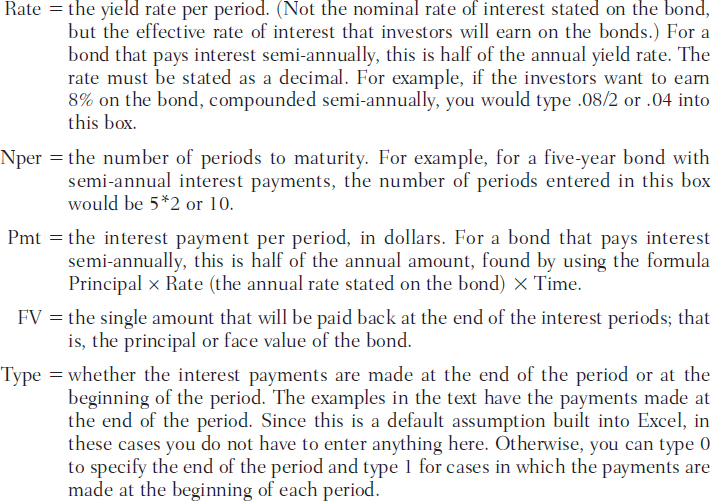
Let's try an example. Refer back to Exhibit 10-4 and the calculation of the present value of the bonds for Baum Company when the assumptions were as follows for Case 1:
| Yield rate | 10% compounded semi-annually |
| Time to maturity | 3 years |
| Face value | $100,000 |
| Bond interest rate | 8% paid semi-annually |
Based on this, the semi-annual interest payments were $4,000 ($100,000 × 8% × ½). If we put these amounts into the PV function in Excel, it will look like this:
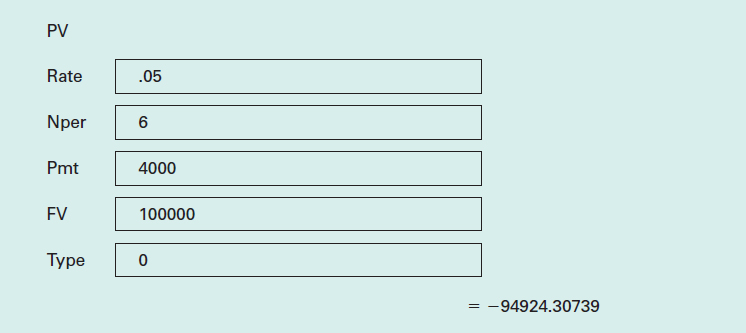
When you press the Enter key or click on the OK button, ($94,924.31) will appear in the spreadsheet cell. (The PV is presented as a negative amount because Excel treats the present value amount as the amount of cash outflow that would be required today to provide for the future inflows of interest and principal.) This value is slightly more precise than the amount of $94,924.76 that we calculated in the chapter, using the tables printed on the inside covers.
A faster way of finding the present value is to click on a cell in Excel and then type the following into the cell:
= PV(.05,6,4000,100000,0)
This accesses the same present value function that we just did above in the longer way. The amounts within the parentheses are the same ones that are in the table shown above. Excel will remind you what values need to be entered by showing (rate, nper, pmt, [fv], [type]) as soon as you have typed = PV.
As another example, refer back to Exhibit 10-4 and calculate of the present value of the Baum Company bonds using the assumptions for Case 2:
| Yield rate | 6% compounded semi-annually |
| Time to maturity | 3 years |
| Face value | $100,000 |
| Bond interest rate | 8% paid semi-annually |
The semi-annual interest payments will still be $4,000. Only the yield rate has changed. Putting these amounts into the PV function in Excel, it will look like this:
When you press the Enter key or click on the OK button, ($105,417.19) will appear in the spreadsheet cell. (The PV is presented as a negative amount for the same reason as stated above.) This value is more precise than the amount of $105,416.76 that we calculated in the chapter, using the present value tables.
Alternatively, you could simply click on a cell in Excel and type the following:
= PV(.03,6,4000,100000,0)
You now have an alternative way to calculate the present value of bonds or other situations involving future payments.
The main advantage of using a computer spreadsheet such as Excel, rather than interest tables, to calculate present values is that you can do so for any yield rate. For example, if the yield or effective rate of interest for a particular type of bond is 8.75%, compounded semi-annually, you are unlikely to find a set of interest tables with a column for 4.375% (i.e., half of 8.75%). Using Excel, however, you would simply enter the rate as .0875/2 or .04375 and have the result in an instant.
SYNONYMS
Bond interest rate ![]() Coupon rate
Coupon rate ![]() Stated rate
Stated rate ![]() Nominal rate
Nominal rate ![]() Contract rate
Contract rate
Capital lease ![]() Finance lease
Finance lease
Deferred income taxes ![]() Future income taxes
Future income taxes
Early retirement of debt ![]() Early extinguishment of debt
Early extinguishment of debt
Market rate of interest ![]() Effective rate
Effective rate ![]() Yield
Yield

GLOSSARY
Accrual entry In the context of pension accounting, this is the journal entry to record the pension expense and create the pension obligation.
Actuary A professional trained in statistical methods who can make detailed estimates of pension costs.
Annuity in arrears A series of payments of equal amounts made at regular intervals, at the end of each specified period.
Bond A corporation's long-term borrowing that is evidenced by a bond certificate. The borrowing is characterized by a face value, interest rate, and maturity date.
Bond interest payment The periodic interest payments made on a bond. The payments are typically made semi-annually, and the amount is calculated by multiplying the bond's face value by its interest rate.
Bond interest rate An interest rate that is specified in a bond contract and used to determine the interest payments that are made on the bond. Synonym for coupon rate, stated rate, nominal rate, and contract rate.
Callable bond A bond that specifies that the issuer can choose to buy the bond back, prior to its maturity, at a predetermined price.
Capital lease Synonym for finance lease.
Collateral trust bond A bond that provides marketable securities as collateral in the event of default by the company.
Convertible bond A bond that is convertible under certain conditions into common shares.
Coupon rate The interest rate stated in a bond contract, specifying the interest that will be paid. Synonym for bond rate, stated rate, nominal rate, and contract rate.
Covenants Conditions or restrictions placed on a company that borrows money. The covenants usually require the company to maintain certain minimum ratios and may restrict its ability to pay dividends.
Debenture bond A bond that is issued with no specific collateral.
Debt to total assets ratio A ratio that compares a company's total liabilities to its total assets, to indicate the extent to which the company has used borrowed funds to finance its assets.
Deferred income tax assets Accounts used to represent tax savings related to the current period that are expected to be realized in future periods.
Deferred income tax liabilities Accounts used to represent additional taxes related to the current period that are expected to arise in future periods.
Defined benefit pension plan A pension plan that specifies the benefits that employees will receive in their retirement. The benefits are usually determined based on the number of years of service and the highest salary earned by the employee.
Defined contribution pension plan A pension plan that specifies how much the company will contribute to its employees' pension fund. No guarantee is made of the amount that will be available to the employees upon retirement.
Discount In the context of bond prices, a term used to indicate that a bond is sold or issued at an amount below its face value.
Discounted cash flows Future cash flows that have been converted to their present-value equivalents, by taking the time value of money into consideration.
Effective interest rate The interest rate that reflects the rate of return earned by investors when they purchase a bond, and the real interest cost to the issuer of the bond. It reflects the competitive market rate for similar bonds, and is used in determining the selling price of the bond. Synonym for market rate or yield.
Face value A value in a bond contract that specifies the cash payment that will be made on the bond's maturity date. The face value is also used to determine the periodic interest payments made on the bond.
Finance lease A lease arrangement that the lessee must treat as the acquisition of an asset and a related long-term liability, as if the transaction represented a purchase of the asset with financing. Synonym for capital lease.
Fully funded plan A pension plan in which the value of the plan assets equals the amount of the projected benefit obligation.
Funding entry The journal entry made to show the cash payment made to the trustee of a pension plan, to fund the obligation.
Indenture agreement An agreement that accompanies the issuance of a bond and specifies all the borrowing terms and restrictions, or covenants.
Investment banker The intermediary who arranges the issuance of bonds in the public debt market on behalf of others. The investment banker sells the bonds to its clients before the bonds are traded in the open market.
Lease agreement An agreement between a lessee and a lessor for the rental or effective purchase of an asset.
Lessee The party or entity that is renting or effectively purchasing the asset in a lease arrangement.
Lessor The owner of an asset that is rented or effectively sold to a lessee under a lease arrangement.
Liability method The method of calculating income taxes that is based on the liability that will be incurred to pay more tax in the future (or the benefit that will be derived from paying less tax in the future) arising from temporary differences between accounting calculations and tax calculations.
Maturity date The date in a bond contract that specifies when the final payment is due.
Mortgage A debt for which some type of real (physical) asset is pledged as collateral in the event of default by the company.
Nominal rate The interest rate stated in a bond contract, specifying the interest that will be paid. Synonym for bond rate, coupon rate, stated rate, and contract rate.
Operating lease A lease in which the lessee does not record an asset and related obligation but treats the lease as a mutually unexecuted contract. Lease expense is then simply recognized as payments are made.
Overfunded A pension plan in which the value of the plan assets exceeds the amount of the projected benefit obligation.
Par In the context of bond prices, a term used to indicate that a bond is sold or issued at its face value.
Post-employment benefits Benefits other than pensions provided to retirees. These benefits are typically health care or life insurance benefits.
Premium In the context of bond prices, a term used to indicate that a bond is sold or issued at an amount above its face value.
Present value The value today of an amount or series of amounts to be received or paid in the future.
Senior debenture A general borrowing of the company that has priority over other types of long-term borrowing in the event of bankruptcy.
Stated rate The interest rate stated in a bond contract, specifying the interest that will be paid. Synonym for bond rate, coupon rate, nominal rate and contract rate.
Subordinated debenture A general borrowing of the company that has a lower priority than senior debentures in the event of bankruptcy.
Temporary differences Differences between accounting and tax reporting that will later reverse themselves and be eliminated. They arise because of the different carrying values of assets and liabilities recorded in a company's accounting records versus its tax records.
Times interest earned ratio A ratio that calculates how many times a company's earnings available to covered interest charges exceed the interest itself, providing a measure of its ability to cover the interest expense out of its earnings.
Time value of money The concept that money received now is worth more than money received later (because money received now can be invested to grow to a larger amount later). Conversely, money is worth less, in economic terms, if it is paid later rather than now. More generally stated, the value of money decreases as the time elapsed until it is received or paid increases.
Trustee In the context of pension plans, an independent party that holds and invests the pension plan assets on behalf of the company and its employees.
Underfunded A pension plan in which the value of the plan assets is less than the amount of the projected benefit obligation.
Underwriter An investment bank that arranges and agrees to sell the initial issuance of bonds or other securities.
Vesting An event by which employees are granted pension benefits even if they leave the company's employ.
Yield The interest rate that reflects the rate of return earned by investors when they purchase a bond, and the effective interest cost to the issuer of the bond. It reflects the competitive rate available in the market for similar bonds, and is used in determining the selling price of the bond. Synonym for effective rate or market rate.

Self-Assessment Quiz
ASSIGNMENT MATERIAL
Assessing Your Recall
10-1 Explain what a loan amortization table is.
10-2 Explain what a “mortgage” is.
10-3 Explain what “blended payments” are.
10-4 Describe the following terms relating to a bond: indenture agreement, bond covenants, collateral, face value, bond interest rate, interest payments, and maturity date.
10-5 Explain what is meant by the yield rate of interest for a bond issue.
10-6 Distinguish between the stated or nominal rate of interest on a bond and the real or effective rate.
10-7 Discuss how bond prices are determined and how these prices are affected by changes in market interest rates.
10-8 Describe the following terms as they relate to bond prices: par, premium, and discount.
10-9 Explain why some bonds are issued at a discount, and what happens to the carrying value of these bonds between their issuance date and maturity date.
10-10 Describe the accounting procedures or journal entries required when bonds are retired before maturity. Why would a company choose to retire debt early?
10-11 Discuss the benefits of leasing, from the point of view of both the lessee and the lessor.
10-12 List and discuss the criteria that are used to distinguish finance leases from operating leases.
10-13 Outline how finance leases are recorded and accounted for.
10-14 Differentiate between defined contribution pension plans and defined benefit pension plans.
10-15 Explain why vesting of the pension benefits and full funding of the pension plan would be important to employees.
10-16 Explain the difficulties in accounting for a defined benefit pension plan.
10-17 Where is information about a company's pension plan assets and projected benefit obligation presented when its financial statements are prepared?
10-18 Explain the nature of deferred income taxes, including how they arise and what they represent.
10-19 Deferred income taxes are usually a liability, but they can also be an asset. Explain what a deferred income tax asset represents.
10-20 Outline how deferred income taxes are calculated.
10-21 Explain the meaning of the terms “temporary differences” and “permanent differences.”
10-22 Explain what the following ratios tell you about a company's financial health: debt to equity ratio and times interest earned ratio.
Applying Your Knowledge
10-23 (Amortization table and journal entries for a mortgage loan)
A company takes out a five-year, $100,000 mortgage on October 1. The interest rate on the loan is 8% per year, and blended payments of $2,027.64 (including both interest and principal) are to be made at the end of each month.
Required:
- The monthly payments will be the same amount each month, throughout the entire term of the loan. Will the interest expense be the same amount each month? Explain briefly.
- Prepare a loan amortization table for this mortgage, similar to the one in Exhibit 10-1. If you do this using a computer spreadsheet such as Excel, you can easily prepare the table for the entire term of the mortgage; if you do it manually, prepare the table for just the first three months.
- Give the journal entries to record the inception of the loan and the first three interest payments.
10-24 (Bond journal entries and financial statement effects)
Spring Water Company Ltd. needed to raise $5 million of additional capital to finance the expansion of its bottled water facility. After consulting an investment banker, it decided to issue bonds. The bonds had a face value of $5 million and an annual interest rate of 7%, paid semi-annually on June 30 and December 31, and will reach maturity on December 31, 2020. The bonds were issued on January 1, 2011, for $4,660,242, which represented a yield of 8%.
Required:
- Spring Water Company issued bonds with a face value of $5 million because it wanted to raise $5 million. However, it succeeded in raising only $4,660,242. Explain why investors were not willing to pay $5 million for the bonds.
- Show the journal entry to record the issuance of the bonds.
- Show the journal entries to record the first two interest payments.
- What amounts will be reported on the financial statements at the end of the first year regarding these bonds?
10-25 (Bonds issued at par—journal entries, including early retirement)
Jason Equipment Ltd. issued 10%, five-year bonds with a face value of $2,800,000 on October 1, 2011. The bonds were issued at par and pay interest on April 1 and October 1 each year. The company's fiscal year end is December 31.
Required:
- Prepare the journal entry for the issuance of the bonds.
- Prepare the journal entry for the bonds for December 31, 2011, and explain why it is necessary to prepare a journal entry on December 31 although it does not coincide with an interest payment date.
- Prepare the journal entries for the interest payments on April 1 and October 1, 2012.
- On October 1, 2012, after paying the semi-annual interest, the company purchased the bonds on the open market and cancelled them. The bonds were purchased at 98 (i.e., at 98% of their face value). Prepare the journal entry to record the purchase and cancellation of the bonds.
10-26 (Bond issuance price, carrying value, and journal entries)
The Standard Mills Corporation issues 1,000 bonds, each with a face value of $1,000, that mature in 12 years. The bonds carry a 6% interest rate and are sold to yield 4%. They pay interest semi-annually.
Required:
- Calculate the issuance price of the bonds, and show the journal entry to record the issuance.
- Explain why the issuance price of the bonds is not the same as their face value.
- Will the carrying value of the liability for these bonds increase over time, or decrease? Explain briefly.
- Show the journal entries to record the first two interest payments on these bonds.
10-27 (Bond issuance price, journal entries, and carrying value)
KD's Cowboy Bar and Grill Ltd. is a country and western–style restaurant and club chain based in Red Deer, Alberta, that specializes in barbecue food and country music. On January 1, it issued five-year, semi-annual bonds with a face value of $200,000, to provide capital to expand the chain. The bond rate was 8% and on the date of sale the yield rate was 10%. Interest payments are to be made each June 30 and December 31.
Required:
- Determine the selling price of these bonds and provide the journal entry to record their sale on January 1.
- Provide the journal entries to record the first two interest payments.
- What amount will be reported for the bond liability on the year-end statement of financial position?
10-28 (Bond issuance price, journal entries, and early retirement)
On April 1, 2011, Tran Corporation issued $20 million of 8% bonds, with interest payable on March 31 and September 30 each year. The market yield rate for these bonds on the date of issuance was 6%. The bonds were dated April 1, 2011, and had a maturity date of April 1, 2021. The company's fiscal year end is December 31.
Required:
- Calculate the cash proceeds from the issuance of these bonds.
- Prepare the journal entries made by the company on April 1, September 30, and December 31, 2011, and on March 31, 2012.
- On April 1, 2012, the company retired the bonds by purchasing them on the open market at 101 (i.e., at 101% of their face value). Prepare the journal entry (or entries) required to record the early retirement of the bonds.
- Explain how a company could record a gain on the early retirement of its bonds even though the amount it paid to repurchase them was more than their face value.
10-29 (Bond issuance prices and journal entries at various yield rates)
Alphabet Toy Company has plans for a plant expansion and needs to raise additional capital to pay for the construction. The company is considering issuing seven-year, 6% mortgage bonds with a par value of $1 million. The bonds will pay interest semi-annually.
Required:
- What are mortgage bonds? Explain how the fact that these are mortgage bonds would affect the interest rate dictated by the market (the yield rate).
- Calculate the amount of cash the company will receive if the bonds are sold at a yield rate of:
- 6%
- 8%
- 4%
- Prepare the journal entry Alphabet Toy would record at the time of the issuance of the bonds under each of the alternative yields. Also prepare the journal entries to record the interest expense for the first two periods under each alternative.
10-30 (Bond selling price, journal entries, carrying value, and early retirement)
Eraser Equipment Company Inc. issued $400,000 of 9% bonds maturing in six years. The bonds pay interest semi-annually and are issued to yield 8%.
Required:
- Calculate the issuance price of the bonds and give the journal entry to record the issuance.
- Give the journal entries to record the first two interest payments.
- Calculate the carrying value of the bonds one year after issuance (that is, at the beginning of the second year).
- Calculate the market value of the bonds one year after issuance, if the market yield has increased to 10%.
- Compare the carrying value (calculated in part “c”) and the market value of the bonds (calculated in part “d”) one year after issuance, and explain why a difference exists.
- Assuming the company retires the bonds at the beginning of the second year by purchasing them in the open market, give the journal entry to record this. (Hint: The amount that you calculated in part “d” should be used in this entry.)
10-31 (Bond calculations and early retirement—partial information)
Black Company issued 10-year, 6% bonds on January 1, 2011. These bonds pay interest every June 30 and December 31. A partial amortization table follows:

Required:
- Calculate the face value of the bonds that were issued on January 1, 2011.
- Calculate the yield rate of interest on these bonds.
- Complete the amortization table for 2011.
- On January 1, 2012, Black retired the bonds at 98 (i.e., at 98% of their face value). Prepare the journal entry to record the retirement of the bonds.
10-32 (Bond calculations and early retirement—partial information)
Crystal Gems Company issued 10-year, 6% bonds on January 1, 2011. These bonds pay interest every June 30 and December 31. A partial amortization table follows:

Required:
- Calculate the face value of the bonds that were issued on January 1, 2011.
- Calculate the yield rate of interest applicable to these bonds.
- Complete the amortization table for 2011 and 2012.
- On January 1, 2013, Crystal Gems retired the bonds by repurchasing them at a price of $208,000. Prepare the journal entry to record the repurchase and retirement of the bonds.
10-33 (Finance lease—journal entries and financial statement balances)
On January 1, 2011, ABC Manufacturing Corporation leased a machine to Start Corporation. The machine had cost ABC $480,000 to manufacture, and would normally have sold for about $600,000. The 10-year lease was classified as a finance lease for accounting purposes.
The machine is expected to have a total useful life of 12 years. However, it will be returned to ABC at the end of the 10-year lease. The lease agreement requires equal semi-annual payments of $44,936 to be made each June 30 and December 31, which reflects an annual interest rate of 10%. Start Corporation closes its books annually on December 31.
Required:
- Calculate the present value of the payments that will be made under this lease agreement.
- Provide the journal entry that should be made by Start Corporation on January 1, 2011, to record the inception of the lease.
- Over what period of time—10 years or 12 years—should Start Corporation depreciate this machine? Explain briefly.
- Assuming that Start Corporation uses straight-line depreciation, provide the journal entry that should be made each December 31 to record the depreciation of this asset.
- Provide the journal entries that should be made by Start Corporation to record the lease payments on:
- June 30, 2011
- December 31, 2011
- June 30, 2012
- December 31, 2012
- What values will be reported on Start Corporation's December 31, 2012, statement of financial position for the leased machine and the lease obligation?
- What values related to the lease will be reported on Start Corporation's statement of earnings for the year ended December 31, 2012?
10-34 (Finance lease—journal entries and financial statement balances)
On July 1, 2011, XYZ Manufacturing Corporation leased equipment to Good Company. The equipment had cost XYZ $500,000 to manufacture, and would normally have sold for about $700,000. The eight-year lease was classified as a finance lease for accounting purposes.
The equipment is expected to have a total useful life of 10 years. However, it will be returned to XYZ at the end of the lease. The lease agreement requires equal quarterly payments of $25,566 to be made each September 30, December 31, March 31, and June 30. These payments reflect an annual interest rate of 8%. Good Company closes its books semi-annually, on June 30 and December 31.
Required:
- Calculate the present value of the payments that will be made under this lease agreement, and show the journal entry that should be made by Good Company on July 1, 2011, to record the inception of the lease.
- Over what period of time should Good Company depreciate this equipment? Explain your reasoning.
- Assuming that Good Company uses straight-line depreciation, provide the journal entry that should be made on December 31, 2011, and June 30, 2012, to record the depreciation of the equipment.
- Provide the journal entries that should be made by Good Company to record the lease payments on:
- September 30, 2011
- December 31, 2011
- March 31, 2012
- June 30, 2012
- What values related to the lease will be reported on Good Company's statement of earnings for the six months ended June 30, 2012?
- What values related to this lease will be reported on the company's June 30, 2012, statement of financial position?
10-35 (Lease classification, journal entries, and financial statement effects)
Transprovincial Buslines experienced a major increase in the volume of its business in the last three months of 2011. Consequently, on January 1, 2012, the company leased a new bus from BigBus Leasing Ltd. Transprovincial could have purchased the bus for $400,000 but decided to lease it instead.
The 10-year lease agreement on the bus requires Transprovincial to pay $5,000 per month at the end of each month starting January 31, 2012. At the end of the lease term, title to the bus transfers to Transprovincial. The lease is structured with a 9% interest rate. The bus is expected to have a useful life of 15 years and will be depreciated on a straight-line basis with no anticipated residual value.
Required:
- Is the above lease a finance lease or an operating lease? Explain why, referring to the criteria for classifying leases.
- Assuming that Transprovincial records the lease on the bus as a finance lease, calculate the present value of the lease payments and give the journal entry that should be made to record the inception of the lease on January 1, 2012.
- Should Transprovincial depreciate the bus over 10 years or over 15 years? Explain.
- Assuming that Transprovincial records depreciation at the end of each month, give the journal entry that should be made to record depreciation for the months of January and February, 2012.
- Give the journal entry that should be made to record the lease payments for January and February, 2012.
- What amounts related to the lease would appear on Transprovincial's statement of earnings for the month of February, and on its statement of financial position as of the end of February?
10-36 (Lease classification, journal entries, and financial statement effects)
Titan Ltd. entered into an agreement to lease manufacturing equipment. The following terms are included in the lease:
- Payments required semi-annually on June 30 and December 31: $9,327 each
- Estimated useful life of equipment: 15 years
- Lease term: 10 years
At the end of the lease term, Titan has the option to acquire the equipment for $10,000. The terms of the lease reflect an annual interest rate of 10%. The lease started January 1, 2011. At that time, the equipment could have been purchased for $120,000.
Required:
- Is the above lease a finance lease or an operating lease? Explain why, referring to the criteria for classifying leases.
- Assuming that Titan records the lease as a finance lease, calculate the present value of the lease payments. (Hint: Include the present value of the $10,000 purchase option to be paid at the end of 10 years.)
- Give the journal entry that should be made to record the inception of the lease on January 1, 2011.
- Should Titan depreciate the equipment over 10 years or over 15 years? Explain.
- Assuming that Titan uses straight-line depreciation, give the journal entry that should be made to record depreciation on December 31, 2011.
- Give the journal entries that should be made to record the lease payments made on June 30 and December 31, 2011.
- What amounts related to the lease would appear on Titan's December 31, 2011, statement of financial position?
10-37 (Lease classification, journal entries, and financial statement effects)
The Provincial Star newspaper signed an agreement on January 1, 2011, to lease a truck for $800 per month for the next four years to deliver its newspapers. These payments are to be made on the last day of each month, and reflect an interest rate of 6% on the lease. The truck will be returned to the lessor at the end of the lease term. The Provincial Star depreciates its assets using the straight-line method and closes its books monthly.
Required:
- Assuming that the truck's fair market value is $70,000 and its expected useful life is 10 years, how should the Provincial Star account for this lease? Explain, referring to the criteria for classifying leases.
- Assuming that the truck's fair market value is $40,000 and its expected useful life is six years, how should the Provincial Star account for this lease? Explain, referring to the criteria for classifying leases.
- Assuming that this lease should be classified as an operating lease:
- Provide the appropriate accounting entries for the first two months of 2011.
- State what (if anything) the Provincial Star would indicate about this lease on its statement of financial position at the end of the first two months.
- Assuming that this lease should be classified as a finance lease:
- Provide the appropriate accounting entries for the first two months of 2011.
- Show what (if anything) the Provincial Star would indicate about this lease on its statement of financial position at the end of the first two months.
10-38 (Income taxes and warranty provisions)
At the end of its first year of operations, Margaret's Manufacturing had earnings of $180,000, before income taxes. One of the expenses that was deducted in determining this amount was product warranty expense of $50,000. However, the amount that was spent to settle product warranty claims during the year (the amount that is deductible for income tax purposes) was only $30,000. The income tax rate was 35%.
Required:
- What amount of product warranty obligation will be reported as a liability on the company's balance sheet at the end of the year?
- Calculate the company's taxable income for the year and the amount of tax that is currently payable.
- Calculate the amount of deferred income tax related to the product warranty. State whether it is a deferred tax asset or a deferred tax liability, and explain your reasoning.
- What amount of income tax expense will be reported on the company's statement of earnings for the year?
10-39 (Income taxes and warranty provisions)
The Hudson Motor Company manufactures engines for small airplanes. The company offers its customers a warranty for five years or 5,000 flying hours. In 2010, the company sold engines valued at $3,000,000 and estimated that the future warranty costs on these engines would be 5% of sales. It incurred costs of $25,000 associated with warranty work on engines during 2010 and $35,000 during 2011.
Required:
- Calculate the deferred income tax asset or liability amount associated with the warranty in 2010. The tax rate is 35%.
- Calculate the deferred income tax asset or liability balance that would appear on the statement of financial position at the end of 2011.
- Where on the statement of financial position would the deferred income tax balance be reported?
10-40 (Income taxes and capital assets)
On January 1, 2010, Precision Machining Company purchased a new machine costing $46,000. The company uses straight-line depreciation for book purposes and capital cost allowance (CCA) for tax purposes. The machine has an estimated useful life of eight years and a $2,000 residual value. For tax purposes, the machine is in an asset class with a CCA rate of 20%. The company's tax rate is 30% and it closes its books on December 31. In both 2010 and 2011, its earnings before depreciation and taxes are $100,000.
Required:
- Calculate the income tax amounts for 2010 and 2011, and give the journal entries for recording the taxes for each year. (Hint: The solution to Practice Problem 4 at the end of this chapter illustrates the steps to be followed in doing this.)
- What amounts would appear on the balance sheet for the deferred income tax asset or liability for 2010 and 2011? Where on the balance sheet would these amounts be reported?
- If you were a banker reviewing this company's financial statements in anticipation of granting it a loan, what importance would you place on the deferred income tax asset or liability balances? Explain.
10-41 (Income taxes and capital assets)
On January 1, 2010, Canadian Corporation purchased a new capital asset costing $51,000. The company estimated the asset would have a useful life of five years and a $3,000 residual value. The company uses straight-line amortization for book purposes, and the asset qualifies for a 30% capital cost allowance (CCA) rate for tax purposes. The company closes its books on December 31, its earnings before depreciation and taxes are $90,000 in both 2010 and 2011, and the income tax rate is 40%.
- Calculate the depreciation expense and the CCA for 2010 and 2011, and determine what the net book value of the asset and its undepreciated capital cost will be at the end of each of these years.
- Calculate the income taxes payable in 2010 and 2011, and determine what the deferred income tax asset or liability balance will be at the end of each of these years. (Hint: You should find that the deferred income tax account will be an asset at the end of 2010 and a liability at the end of 2011.)
- Explain why the deferred income tax account changes as it does, over this two-year period.
- Give the journal entry to record the company's income taxes for 2010 and 2011.
10-42 (Income taxes and capital assets)
At the beginning of 2010, Maritime Manufacturing Company acquired a capital asset costing $500,000 that was expected to have a residual value of approximately $50,000 at the end of its productive life. The company decided to depreciate it using the production method, which resulted in depreciation expense of $70,000 in 2010 and $60,000 in 2011. For tax purposes, a capital cost allowance rate of 20% was applicable to this asset. In 2010, the company had earnings before depreciation and tax of $400,000. The income tax rate was 45%.
Required:
- Calculate the amount of income tax payable for 2010.
- What is the balance in the deferred income taxes account at the end of 2010? Be sure to specify whether it is an asset or a liability.
- Explain briefly what this balance (in the deferred income taxes account) represents.
- Calculate the amount of income tax expense for the company in 2010.
- What amount of capital cost allowance can be deducted in 2011?
- By what amount will the deferred income taxes account change during 2011?
- What will be the balance in the deferred income taxes account at the end of 2011? Again, be sure to specify whether it will be an asset or a liability.
- Explain briefly how the balance in the deferred income taxes account is related to the asset's carrying values (i.e., the net book value for accounting purposes and the undepreciated capital cost for tax purposes).
User Perspective Problems
10-43 (Blended payments)
From a management perspective, what is the advantage of having long-term loans such as mortgages structured to be repaid through equal, blended monthly payments?
10-44 (Collateral for long-term debt)
As a potential lender considering making a long-term loan to a company, discuss how much comfort you might get from knowing what long-term assets the company has, specifically in the form of (1) property, plant, and equipment and (2) goodwill. As well as the existence of these assets, what else would you like to know?
10-45 (Seniority of liabilities)
In assessing the riskiness of investing in a particular bond, discuss the importance of being aware of the seniority of various company liabilities.
10-46 (Bond covenants)
Why do bond investors like to see restrictive covenants included in bond indenture agreements? Give two examples of common bond covenants, and explain why each would be beneficial to bond investors.
Suppose that you are a stock analyst and you are evaluating a company that has a significant number of operating leases.
Required:
- Discuss the potential misstatement of the financial statements that may occur because of this treatment. Specifically, address the impact of this type of accounting on the debt to total assets ratio and return on total assets ratio.
- Using disclosures provided in the notes to the financial statements, explain how you could adjust the statements to address the issues discussed in part “a.”
10-48 (Finance leases)
A shareholder recently charged that the financial statements of a company in which he owned shares were false and misleading because a large amount of computer equipment, which the company leased from a financial institution and did not actually own, was included among the company's capital assets. Is the company's treatment appropriate? Explain.
10-49 (Lease classification criteria)
“If two separate companies were each to lease identical capital assets under identical lease terms, the finance lease criteria used under International Financial Reporting Standards will ensure that each company reports the transaction in the same way.”
As a financial statement analyst, would you agree or disagree with this statement? Explain.
10-50 (Impact of lease classification on earnings)
Suppose that your company leases a valuable asset and you are a manager whose remuneration is partially tied to the company meeting a particular earnings target. How is your ability to meet the earnings target affected by the decision to record the lease transaction as either an operating lease or finance lease? Which accounting treatment would you prefer? Does your answer depend on whether you are in the early years of the lease rather than the later years?
10-51 (Lease or buy decision)
Starburst Brewery Ltd. must replace some of its old copper equipment with new stainless steel equipment. The controller is unsure whether to lease the equipment or purchase it with borrowed money.
If purchased, the equipment will cost $800,000 and have an estimated useful life of 16 years and no residual value. The company's bank is willing to provide the $800,000 to Starburst, through a 10-year note bearing 8% annual interest payable at the end of each year. The principal amount would be due at the end of the 10 years.
A local rental company is willing to lease the equipment to Starburst for 12 years at an interest rate of 7%. At the end of each year, Starburst would be required to pay the leasing company $100,000. At the end of the lease period, title to the equipment would remain with the lessor.
Required:
- Calculate the present value of the future cash flows under both arrangements.
- State what amounts would appear in Starburst's statement of earnings and statement of financial position for the first year, under both alternatives. (Assume the new equipment is acquired on January 1.)
- What factors, other than cash payments directly related to financing, might be important to the decision?
- Which of the two financing alternatives would you recommend to the controller? Why?
10-52 (Pension plan alternatives)
Describe the two main types of pension plans. As a manager, which type of plan would you recommend to the company's senior executives? Explain. As an employee, which plan would you prefer? Explain.
10-53 (Post-employment benefits)
Accountants now have to accrue the cost and record the future obligation for post-employment benefits. In the past, the cost of these benefits was simply recorded as it was incurred (the pay-as-you-go approach). As a manager, explain why you would prefer to continue to use the pay-as-you-go method. What accounting concepts support the change in accounting method from the pay-as-you-go approach to recognizing the future obligation before the employees retire?
10-54 (Unrecorded liabilities)
In assessing the risk of investing in a company, stock analysts are often very concerned that there may be liabilities that do not appear on the company's financial statements. Discuss the major types of these “off-balance-sheet” liabilities, and describe the information about them that may be included in the notes to the financial statements.
10-55 (Risks associated with liabilities)
Notes to the financial statements regarding liabilities typically include the interest rates and payment terms on major debts, as well as details of any foreign currency repayment requirements. Why are such disclosures important to a financial statement analyst?
10-56 (Valuation of liabilities)
Does the concept of fair market value apply to liabilities? Is the market value the same as the book or carrying value reported on the statement of financial position? Explain. Which value would be more relevant to financial statement users?
10-57 (Deferred income taxes as liabilities)
Some users of financial statements do not believe that deferred income tax liabilities meet the criteria for recognition as liabilities. Discuss deferred income tax liabilities in terms of the criteria for recognizing liabilities, and provide your own arguments about whether they satisfy the criteria.
10-58 (Deferred income taxes and lending decisions)
As a potential lender, discuss how you might view the nature of a deferred income tax liability on a company's statement of financial position, and whether you would treat it in the same way as you would a long-term bank loan.

Financial Analysis Assignments
Reading and Interpreting Published Financial Statements
10-59 (Revolving debt facility)
Headquartered in Toronto, Maple Leaf Foods Inc. is a food processing company with operations across Canada, the United States, Europe, and Asia. It produces meats and meal products, as well as fresh and frozen pork, chicken, and turkey products, and also produces livestock nutrition products and pet foods in its agribusiness group. Note 8 to the company's 2009 financial statements provides details of Maple Leaf's long-term debt. An excerpt follows:
8. e. Long-term debt
The Company has an unsecured revolving debt facility with a principal amount of $870.0 million. The maturity date is May 31, 2011. This facility can be drawn in Canadian dollars, U.S. dollars, or British pounds, and bears interest based on bankers' acceptance rates for Canadian dollar loans and LIBOR for U.S. dollar and British pound loans. As at December 31, 2009, $476.6 million of the revolving facility was utilized (2008: $559.8 million)…
Required:
- What is a revolving debt facility?
- The revolving debt facility is described as unsecured. What does this mean?
- Why would a company want to be able to borrow in Canadian dollars, U.S. dollars or British pounds? How does this capability affect the company's financial risk?
- How much is outstanding on the revolving debt facility as at December 31, 2009? Do you know what currency the company borrowed that sum in? Explain.
10-60 (Long-term debt)
Suncor Energy Inc. is a major developer in the oil sands of Northern Alberta. Note 17 to Suncor's financial statements (Exhibit 10-15) describes the company's long-term debt as at December 31, 2009.
Required:
- Suncor has revolving-term debt. Explain in your own words what the major features of this type of debt are.
- The revolving-term debt bears interest at variable interest rates. What advantages are there for a company to borrow at variable interest rates? How does this affect the risk of investing in Suncor?
- Suggest possible reasons why the company has borrowed in U.S. dollars. How does this affect the risk of investing in Suncor?
- The company has not disclosed the minimum cash payments that it must make on its debt over the next five years and a cumulative amount for the years after the fifth year. Why would this type of disclosure be important to users?
- You would expect that a company in the oil industry would lease some of its facilities and equipment. Does Suncor have any leases? How do you know? What kind of leases are they?
EXHIBIT 10-15 SUNCOR ENERGY INC. 2009 ANNUAL REPORT
SUNCOR ENERGY INC. 2009 ANNUAL REPORT
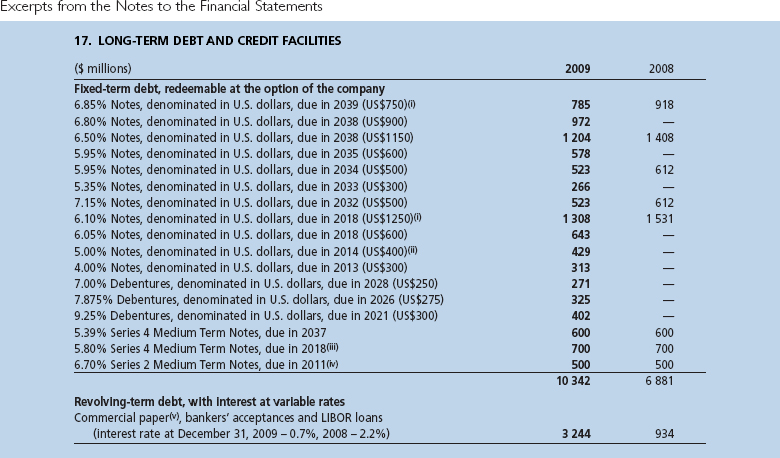
Loblaw Companies Limited distribute food, general merchandise, and financial products and services across Canada, through Superstore, Extra Foods, Dominion, Fortinos, No Frills, Independent, Zehrs, Dominion and Provigo, as well as Loblaws stores. Their brands include President's Choice, no name, and Joe Fresh Style. Exhibit 10-16 contains excerpts from three notes related to long-term liabilities accompanying Loblaw Companies Limited's 2009 financial statements. All dollar amounts in the notes are in millions.
EXHIBIT 10-16A LOBLAW COMPANIES LIMITED 2009 ANNUAL REPORT
LOBLAW COMPANIES LIMITED 2009 ANNUAL REPORT
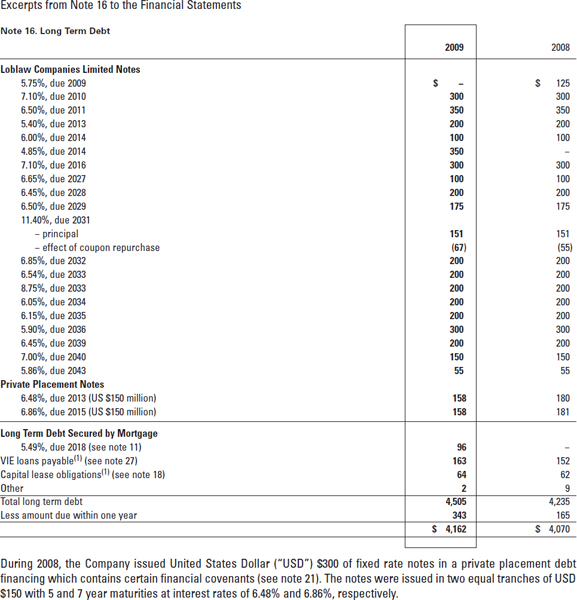
 EXHIBIT 10-16B LOBLAW COMPANIES LIMITED 2009 ANNUAL REPORT
EXHIBIT 10-16B LOBLAW COMPANIES LIMITED 2009 ANNUAL REPORT
- Looking at Loblaw's series of notes outstanding and the recent private placement, what do you think the relationship is between interest rates and the length of time to maturity of a loan? As an investor, explain why this relationship would be important to you.
- Compare the rate of interest on the long-term debt secured by a mortgage that is due in 2018 to the note due in 2016. Why do you think the debt due in 2018 has a lower interest rate than the note due in 2016?
- Explain why Loblaw would spread out the maturities of their debt over such a long period of time. When they issued the private placement notes, why did they not arrange to have both tranches mature at the same time?
- What is meant by a private placement?
- Are capital (finance) leases a major form of long-term financing for Loblaw? Support your answer.
- Does Loblaw use many operating leases? Why might an analyst be concerned with Loblaw's operating leases?
- What type of covenants are attached to Loblaw's long-term debt? Explain why these covenants would be useful to lenders or investors. (Hint: The times interest earned ratio is sometimes referred to as an interest coverage ratio. A leverage ratio is one that measures the amount of debt in a company's capital structure, relative to either the assets or the shareholders' equity.)
10-62 (Long-term debt)
Bombardier Inc. is an international provider of aerospace and transportation equipment and solutions. Exhibit 10-17 presents excerpts from Note 13 to Bombardier's 2010 financial statements, which describes the company's long-term debt. All amounts are in millions of U.S. dollars.
EXHIBIT 10-17 BOMBARDIER INC. 2010 ANNUAL REPORT
BOMBARDIER INC. 2010 ANNUAL REPORT
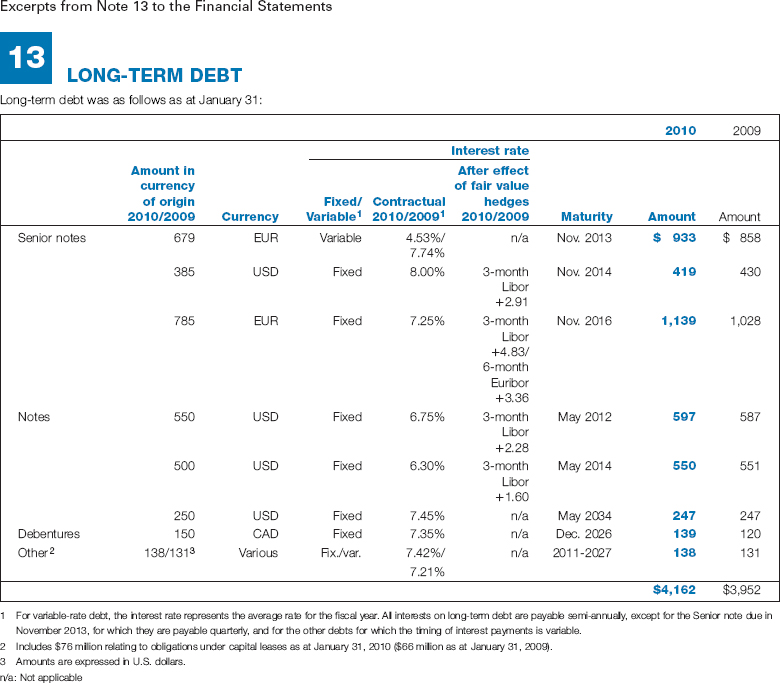
Required:
- Bombardier has three senior notes outstanding, with two in euros (one at a fixed rate and one at a floating rate) and one in U.S. dollars. They are due at different times. Why would the company choose to issue three different kinds of debt rather than consolidate all of its financing needs into one note?
- In the list of all of its long-term debt, Bombardier has senior notes, notes, and debentures. Briefly highlight the differences between these three types of debt instruments.
- The company has debt instruments denominated in several different currencies. What advantages would there be for Bombardier in this strategy? (Hint: Think about where Bombardier does business.)
10-63 (Leases)
Ballard Power Systems Inc. designs, manufactures, and sells fuel cells and has its head office, research and development, and manufacturing facilities in Burnaby, British Columbia. Exhibit 10-18 presents Note 10 from Ballard's 2009 financial statements, which describes the company's capital (finance) lease obligations.
Required:
Based on the information in the note, explain why Ballard's lease for the production and test equipment is classified as a finance (capital) lease rather than an operating lease.
EXHIBIT 10-18 BALLARD POWER SYSTEMS INC. 2009 ANNUAL REPORT
BALLARD POWER SYSTEMS INC. 2009 ANNUAL REPORT
10-64 (Pensions and other long-term benefits)
An excerpt from Note 18 to the 2009 financial statements of The Lindt & Sprüngli Group, dealing with employee benefits, is presented in Exhibit 10-19. As you probably know, Lindt & Sprungli is a Swiss-based manufacturer of fine chocolates.
Required:
- What types of pension plans and other long-term benefit plans does Lindt & Sprüngli have?
- In Lindt & Sprüngli's 2009 statement of earnings, what are the total expenses related to the pension and long-term benefit plans?
- What is the total pension plan obligation for Lindt & Sprüngli as at December 31, 2009?
- What is the total fair value of pension plan assets for Lindt & Sprüngli as at December 31, 2009?
- Are Lindt & Sprüngli's pension plans underfunded or overfunded, and by what amount?
- What is the net asset or liability related to pension plans that is reported on Lindt & Sprüngli's balance sheet as at December 31, 2009?
 EXHIBIT 10-19 LINDT & SPRÜNGLI 2009 ANNUAL REPORT
EXHIBIT 10-19 LINDT & SPRÜNGLI 2009 ANNUAL REPORT
10-65 (Income tax disclosures)
Research In Motion Limited—or RIM—is a leading designer, manufacturer, and marketer of wireless solutions for the worldwide mobile communications market, including the BlackBerry communications device. Exhibit 10-20 presents a portion of Note 10 to RIM's 2010 financial statements, with details about its income taxes.
Required:
- For the fiscal years ending in 2010 and 2009, calculate the percentage of RIM's provision for income taxes that had to be paid in the current period and the percentage that was deferred to the future.
- For the fiscal years ending in 2010 and 2009, calculate the percentage of RIM's total provision for income taxes that was Canadian and the percentage that was foreign.
10-66 (Debt to total assets and times interest earned ratios)
The 2009 consolidated balance sheet and statement of earnings for Maple Leaf Foods Inc., a global food processing company based in Toronto, are included in Exhibit 10-21.
Required:
- Calculate the debt to total assets ratios and the times interest earned ratios for the years ending December 31, 2009 and 2008. (Hint: The “non-controlling interest” amount on the balance sheet should not be included in total liabilities.)
- Identify the major factors that caused the changes in these ratios.
- Write a short report commenting on the results of the ratio calculations in part “a.”
10-67 (Debt to total assets and times interest earned ratios)
Carnival Corporation & Group plc is a global company that operates several cruise lines—including Carnival Cruises, Princess Cruises, and Holland America—offering cruises in Europe, North America, and Australia. The statement of operations and consolidated balance sheet from Carnival's 2009 annual report are presented in Exhibit 1-10A and B on pages 66–67.
Required:
- Calculate the debt to total assets ratios and the times interest earned ratios for 2009 and 2008.
- Identify the major factors that contributed to the changes in these ratios.
- Write a short report commenting on the results of the ratio calculations that you did in part “a.”
 EXHIBIT 10-20 RESEARCH IN MOTION LIMITED 2009 ANNUAL REPORT
EXHIBIT 10-20 RESEARCH IN MOTION LIMITED 2009 ANNUAL REPORT
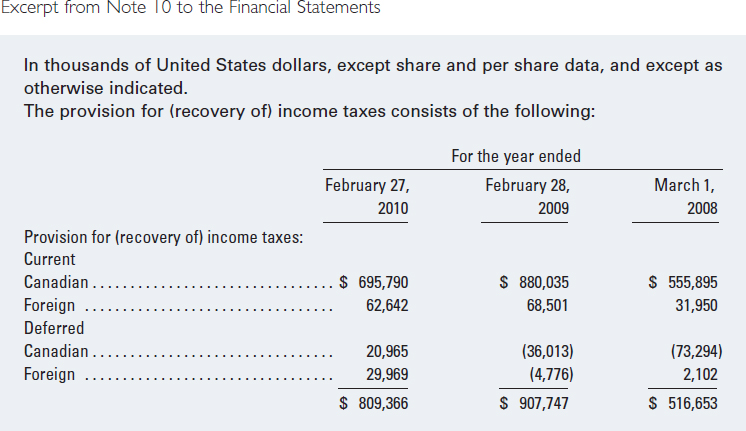
EXHIBIT 10-21A MAPLE LEAF FOODS INC. 2009 ANNUAL REPORT
MAPLE LEAF FOODS INC. 2009 ANNUAL REPORT
 EXHIBIT 10-21B MAPLE LEAF FOODS INC. 2009 ANNUAL REPORT
EXHIBIT 10-21B MAPLE LEAF FOODS INC. 2009 ANNUAL REPORT
BEYOND THE BOOK
10-68 (Analysis of a company's liabilities)
Choose a company as directed by your instructor and do the following:
- Prepare a quick analysis of the non-current liability accounts by listing the beginning and ending amounts in these accounts and calculating the net change, in both dollar and percentage terms, for the most recent year.
- If any of the accounts changed by more than 10%, try to give an explanation for the change.
- What percentage of the company's total liabilities is in the form of long-term bank loans? Long-term bonds? Have these percentages changed significantly over the last year?
- What interest rates is the company paying on its long-term debt? (Hint: You will probably need to look in the notes to the financial statements to find the answer to this question.)
- Calculate the company's debt to total assets ratio and its times interest earned ratio. To the extent that you can, based on this limited analysis, comment on the company's financial health in terms of its level of debt and interest expense.
- Read the company's note on income taxes and answer the following questions:
- What are the major items that caused the company's effective tax rate to be different from the statutory tax rate?
- What are the major items that created deferred (or future) income tax assets and/or liabilities for the company?
Cases
10-69 Regal Cars
Regal Cars has been manufacturing exotic automobiles for more than 50 years. It has always prided itself on its top-quality products and high levels of customer satisfaction. All Regal Cars are hand-built to the purchasers' individual specifications. In the past year, the popularity of Regal Cars has increased dramatically following a promotional campaign in which Regal provided complimentary cars to star members of the local NHL team. To meet the increasing demand, Mark Quaid, the president and largest shareholder of Regal Cars, is considering partially automating the production line.
To finance the conversion of the manual production line to a robotic system, Quaid will have to raise more than $1 million in capital. The company has been in the Quaid family for more than 50 years and Mark is unwilling to sell shares and risk diluting his family's equity in the business. As an alternative to equity financing, he has identified three potential sources of debt financing and has asked you to explain how each option would affect the company's financial statements.
Option 1—Bank loan
A national bank has offered to lend Regal the necessary funds in the form of a 10-year, 12% bank loan. Annual payments of $100,000 plus interest will be required. Because of the loan's size, the bank would require Mark Quaid to personally guarantee the loan with a mortgage on the family estate.
Option 2—Bond issue
Regal can issue 10-year, 10% bonds for the amount required. Currently, similar bonds in the market are providing a return of 10%.
Option 3—Lease
Regal can lease the equipment. The lease would require annual payments of $104,000 over a 10-year lease period. The present value of these payments, at an annual interest rate of 8%, would be $697,850. The equipment is expected to have a useful life of 12 years and to be worth about $100,000 at the end of the 10 years.
Required:
Prepare a memo to Mark Quaid discussing how each of these options would affect the company's financial statements. You should also include in your memo any other pertinent observations that could influence the financing decision he has to make.
10-70 Jonah Fitzpatrick
Jonah Fitzpatrick would like to start investing and is considering purchasing some of the bonds being issued by Jennings Financial. Details of the bond issue were outlined in a recent article in Financial Times Magazine. The following is an excerpt from the article:
Jennings Financial is planning to issue a series of bonds to help finance the acquisition of a large manufacturing facility. In consultation with its investment bankers, the company has decided to issue $100 million of 8%, five-year bonds. Each bond will be denominated at $1,000. The bonds will be classified as senior debenture bonds and will be sold to yield a return of 10%. Because this is such a large issue, the investment banker is required to underwrite the issue. However, given the company's historical performance and financial strength, a syndicate is willing to guarantee the entire issue.
Jonah is unfamiliar with bond issues and approaches Mike Jacobs, his stockbroker, with some basic questions.
| Jonah: | I've always invested in equity securities, Mike, but I want to consider investing in the bonds being issued by Jennings Financial. I know very little about bonds, though, so I have a few questions. |
| Mike: | Sure thing, Jonah. Just e-mail your questions and I'll get back to you later today. |
Jonah has just sent Mike the following e-mail. Draft an appropriate response.
Mike, here are my questions on the Jennings bonds. I look forward to hearing from you.
- The advertisement for the bond issue states that the bonds will be 8% bonds but will yield 10%. Why are there two interest rates? Which interest rate should I use to determine how much I'll earn on the bonds?
- What are debenture bonds? Will I have any security if the company defaults on these bonds?
- What is the role of the investment banker? What does it mean to use a syndicate?
- What if I need my money back before the end of the five-year period? Does the five-year term mean that I would be locked into this investment for five years?
10-71 Wasselec's Moving and Storage
Wasselec's Moving and Storage is a small company based in Hamilton, Ontario. It operates in both the residential and commercial markets. To serve its various clients, Wasselec's owns two large moving trucks (tractor-trailer units), six medium-sized cartage trucks, two large vans, and two cars. Because its business relies on its vehicles, it has always been the company's policy to purchase new vehicles on a regular rotation basis. Its accountant and vehicle service manager have established guidelines that trigger the purchase of a new vehicle. For example, the large vans are replaced every 200,000 kilometres, the tractors every 10 years, and the trailers every 15 years.
The president of the company recently read an article about the increasing trend toward leasing. She wonders if Wasselec's should start leasing its vehicles instead of buying them, and has asked the chief financial officer (CFO) for guidance in this matter. In turn, the CFO has asked you, a recent addition to the company's staff, to prepare a summary of the advantages and disadvantages of ownership versus leasing.
Required:
Draft a memo to the CFO summarizing the advantages and disadvantages of ownership and leasing, with reference to the types of assets currently owned by Wasselec's Moving and Storage. The CFO is very busy, so your memo should be concise.
10-72 Grant's Ice Cream Shop
Jack and Gillian Grant, owners of Grant's Ice Cream Shop, have recently expanded their business by moving into a second location in a nearby town. To open the second location, the company had to obtain three large ice cream machines. To buy the machines would have cost over $15,000, so Jack and Gillian decided to lease them instead.
The lease term is for five years and the machines are expected to have a useful life of eight to 10 years. According to the lease contract, the present value of the lease payments over the lease term is $12,000 and the Grants will have the option to purchase the leased machines for $1,000 at the end of the five-year lease term. Their fair market value is expected to be approximately $4,000 at the end of the lease.
Jack Grant is thrilled with the arrangement. “Not only do we get the machines that we need without a large initial cash outlay, but we don't have to record any liability on the statement of financial position; we can just report the annual lease payments as equipment rental expense on the statement of earnings.”
Required:
Is Jack correct in assuming that the lease payments will be recorded as an expense and that no debt will have to be reported on the statement of financial position as a result of this transaction? Explain your answer fully, by referring to the criteria for lease classification and the appropriate accounting treatment for this type of lease.
As part of recent contract negotiations, Peterson Corporation has presented two pension plan options to its employees. The employees are to vote on which plan they would like the company to implement. Peterson Corporation owns and operates a chain of grocery stores throughout western Canada and employs more than 3,000 people. Most employees have little education and very limited accounting knowledge. Your cousin, Karen Cooper, is a cashier at a Peterson store located in Kamloops, British Columbia, and she has asked you for help in determining which pension option to vote for. She is confused over the terminology used in the proposal and would like you to explain the two alternatives in simpler terms, so that she can make an informed decision.
Option 1
The company will establish a defined contribution pension plan. The company will contribute 10% of the employee's gross wages to the pension plan each pay period. Vesting will occur immediately and the funds will be placed with an independent trustee to be invested. Employees will have the option of contributing additional funds to the plan.
Option 2
The company will establish a defined benefit plan. The plan will guarantee that each employee will receive 2% of the average of their highest five years of salary multiplied by the number of years the employee works for the company. The plan will be fully employer-funded and the pension entitlement will vest after five years of continuous service.
Required:
Briefly explain to Karen the difference between the two pension plan options. You should remember that Karen is unfamiliar with pension terminology and you therefore have to explain some of the terms used in the plan descriptions.
Critical Thinking Question
10-74 (Pension plan disclosures)
For defined benefit pension plans, a formula has been devised for calculating the pension expense to be recognized each accounting period. The amount of funding (i.e., cash transferred from the company to the pension plan trustee) is usually a different amount than the expense. When the amount of cash that is transferred is less than the pension expense that is recognized, a liability for the difference results. When the opposite occurs (i.e., the amount of cash transferred to the trustee is greater than the pension expense), an asset results.
The difference between the two amounts in any particular period is a reflection of the pension plan being either overfunded or underfunded that individual period. However, these amounts are usually insignificant compared with the corporation's total liability for the pension plan and its cumulative status in terms of being overfunded or underfunded.
Required:
Describe the current disclosure requirements for pensions. Should a company be required to include a liability on the statement of financial position that reflects its total future obligation with respect to its pension plan? What impact would such a requirement have on the debt to total assets ratio? Are users of financial statements being given enough information about pension plans to allow them to make informed decisions?
1. As a Crown Corporation, Canada Post is owned by the federal government and does not have outside shareholders. It therefore does not have the option of raising equity capital by issuing shares.
3. For situations where a lease is on the borderline of being classified as either an operating lease or a finance lease using the five primary criteria, the following three secondary indicators should also be considered:
- Any cancellation losses are borne by the lessee.
- Any gains or losses from fluctuations in the residual value accrue to the lessee.
- There is a bargain lease renewal option.
If any of these criteria are met, they indicate that the true substance of the lease is such that it should be classified as a finance lease.
4. Normally, lease payments are made at the beginning of each period, rather than at the end. However, this makes the calculations of present value and interest expense somewhat complicated for an introductory text. Therefore, we are making the simplifying assumption that the lease payments are made at the end of each period.


